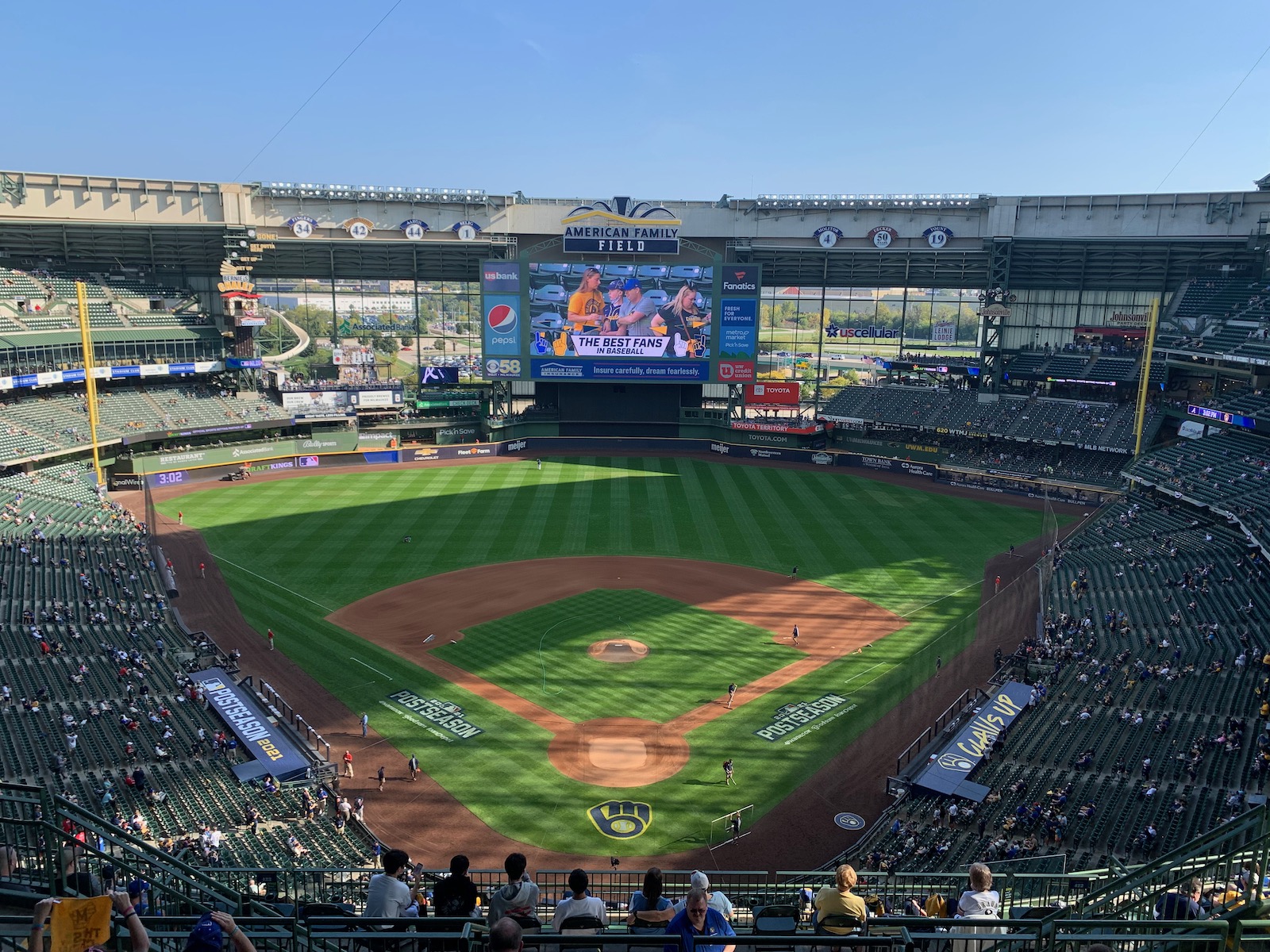

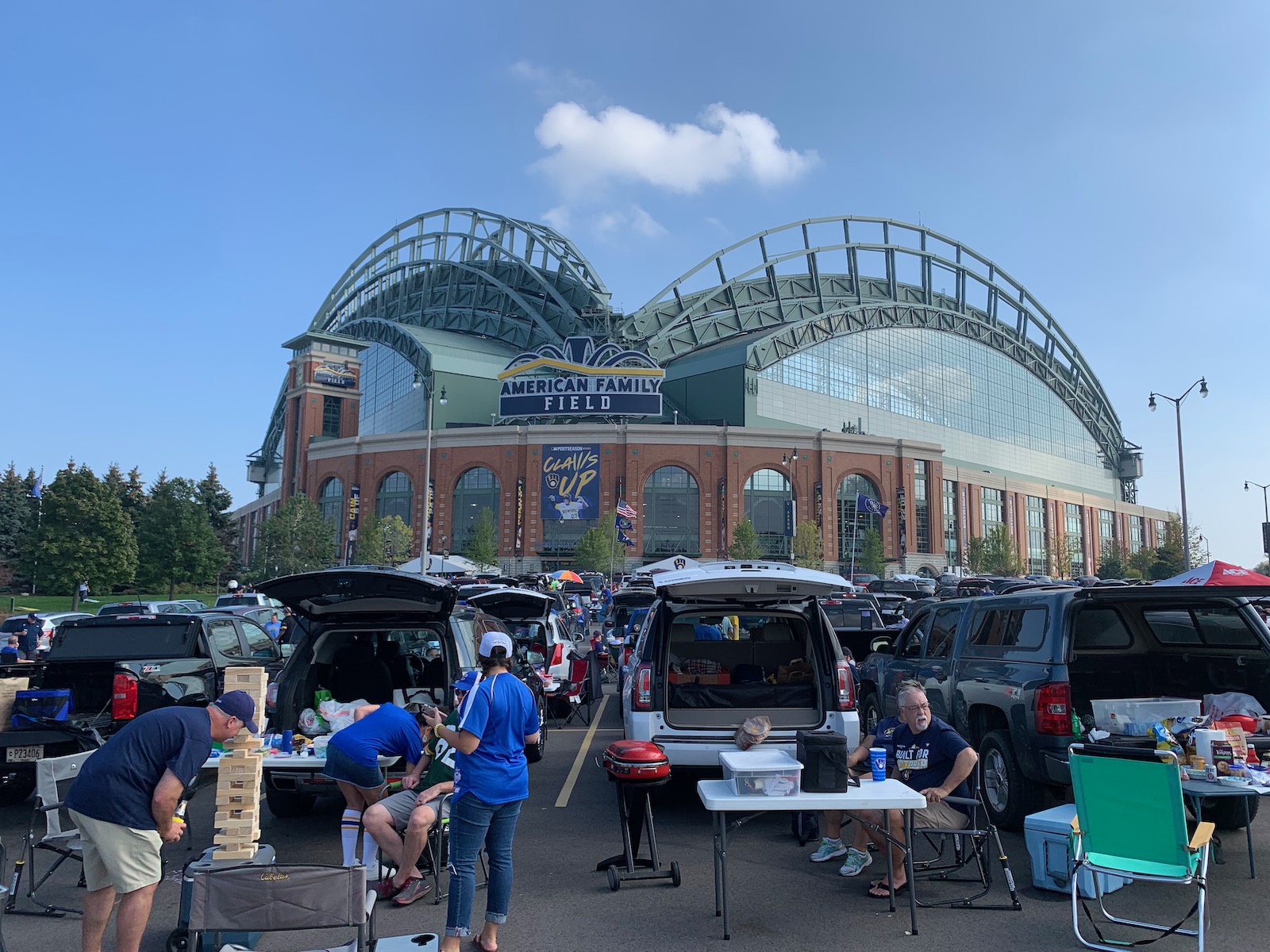
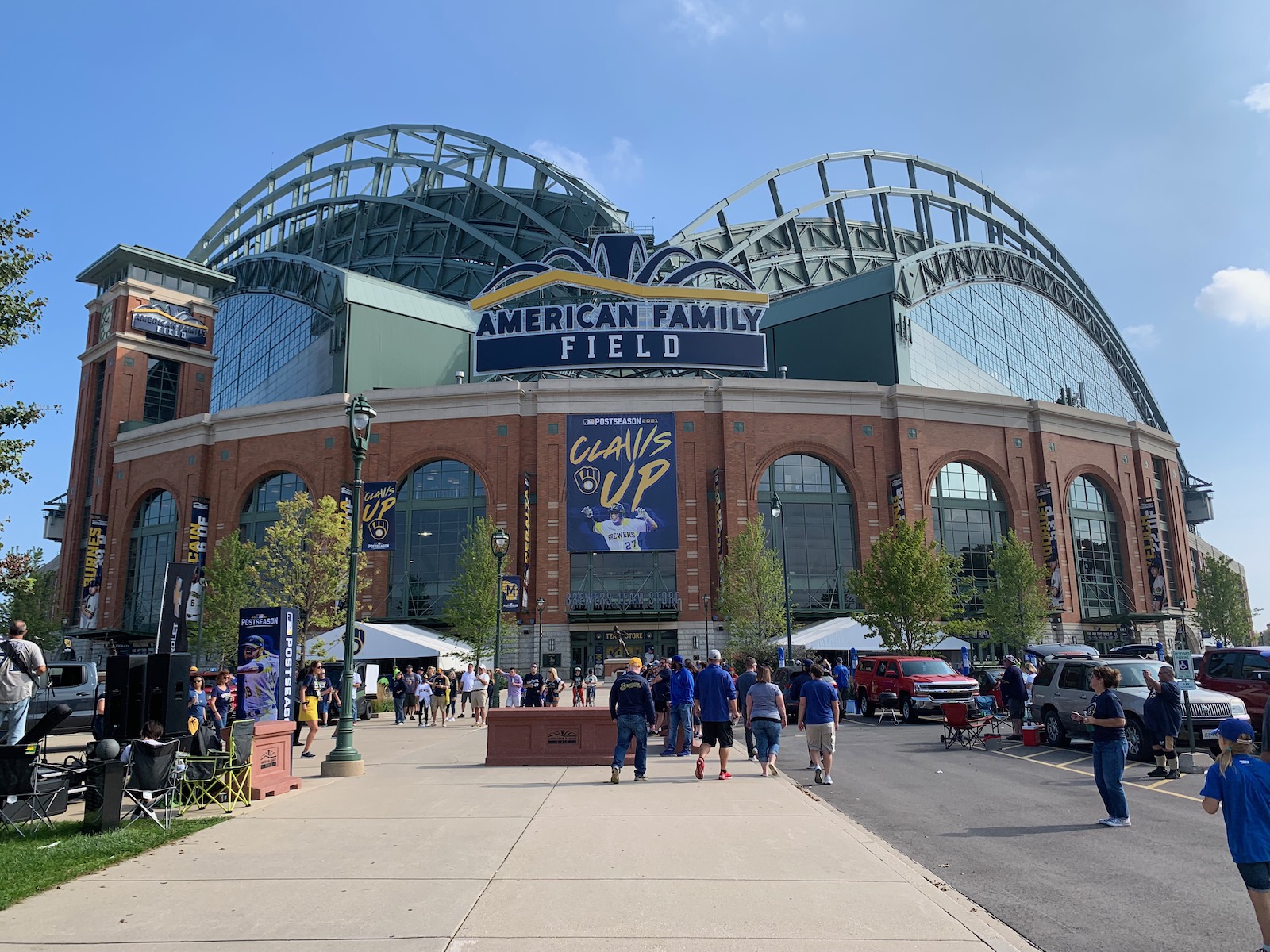
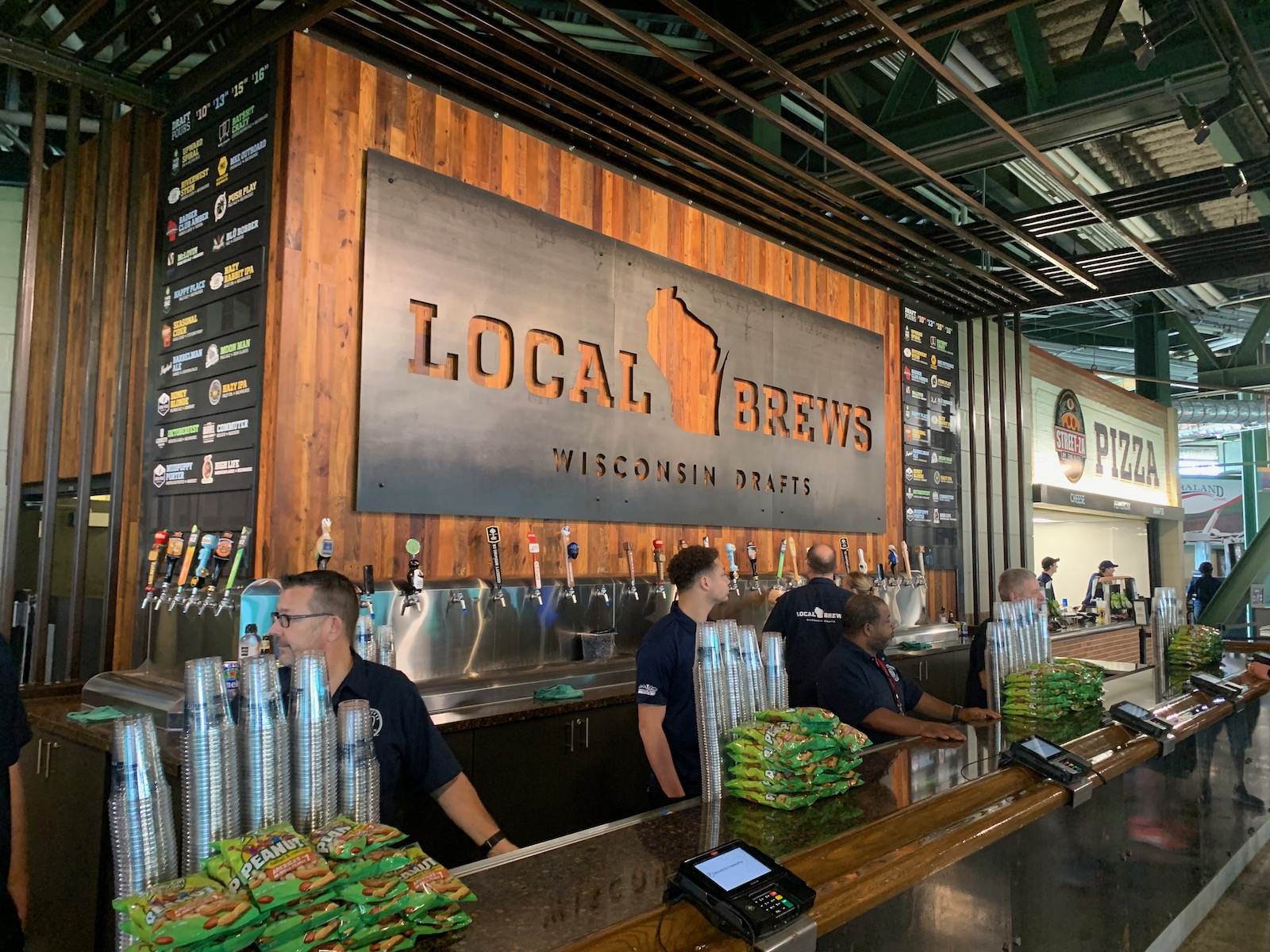
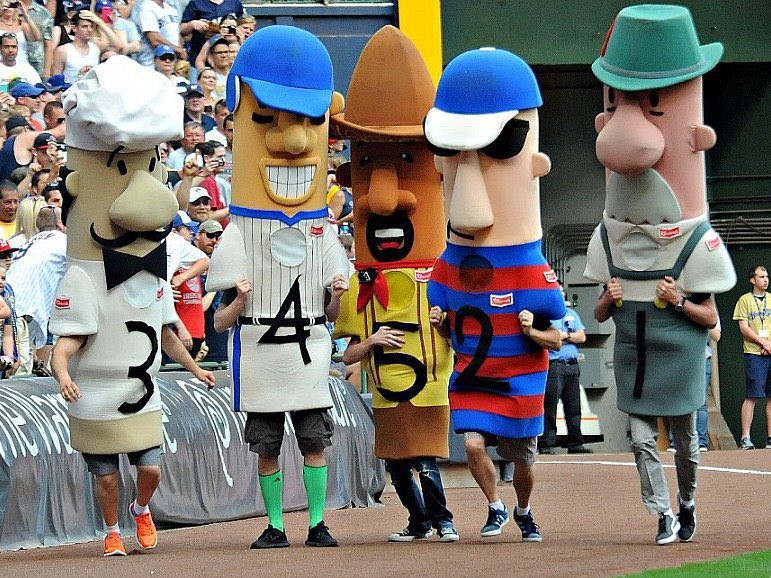
American Family Field
| Setting | 10/20 | 1 Thumb Down |
|---|---|---|
| Locale | 2.5/5 | 1 Thumb Down |
| Accessibility | 3/5 | 1 Thumb Down |
| Neighborhood Local Scene | 4.5/10 | 1 Thumb Down |
| Architecture & Aesthetics | 33.5/65 | 1 Thumb Down |
|---|---|---|
| Exterior Design/Aesthetics | 11.5/20 | Thumb Sideways |
| Interior Aesthetics/Visuals | 18/40 | 1 Thumb Down |
| Concourse Aesthetics | 4/5 | 1 Thumb Up |
| Functionality & Essentials | 32.5/50 | 1 Thumb Down |
|---|---|---|
| Sightlines: Field Proximity | 9.5/15 | 1 Thumb Down |
| Sightlines: Seating Geometry | 3.5/5 | Thumb Sideways |
| Seat Comfort | 5.5/9 | Thumb Sideways |
| Concourse Functionality | 11/15 | Thumb Sideways |
| Scoreboards/Tech | 3/6 | Thumb Sideways |
| Amenities & Features | 37/50 | 1 Thumb Up |
|---|---|---|
| Concessions: Food Variety | 3.5/5 | Thumb Sideways |
| Concessions: Food Quality | 4.5/5 | 1 Thumb Up |
| Concessions: Craft Beer/Other Drinks | 4.5/5 | 1 Thumb Up |
| Social Gathering Areas/Restaurants | 7.5/10 | Thumb Sideways |
| Premium Seating/Clubs | 4.5/9 | 1 Thumb Down |
| Historical Exhibits, Memorabilia, Art, & Other Displays | 7/10 | Thumb Sideways |
| Kids Areas/Other Entertainment | 5.5/6 | 1 Thumb Up |
| Atmosphere, Vibe, & Policies | 14/15 | 2 Thumbs Up |
|---|---|---|
| Fan Support/Attendance | 4/5 | 1 Thumb Up |
| Ballpark Traditions/Gameday Presentation | 5/5 | 2 Thumbs Up |
| Ballpark Policies/Staff | 5/5 | 1 Thumb Up |
| Adjusted Raw Score | 127/200=63.5 |
|---|---|
| Bonus | 4 |
| Curve for All 7 | 7 |
| Final Score | 74.5 |
|---|---|
| Ranking | #24/30 |
|---|---|
A First Class Sausage Race
Despite no regard for interior aesthetics, lack of intimacy, Miller Park compensates by bringing a taste of Milwaukee
By: Cole Shoemaker
Written in 2011 when ballpark was named Miller Park; ratings above are up to date for 2023, but this review below may be outdated and will be updated at some point during the 2023 season; reviews and ratings are “living pages” updated yearly when necessary
Well at least the Brewers can say this: in 20 years, out of all the retro ballparks constructed in America, their retro ballpark will be the most identifiable as a landmark of their city. With its massive exterior arches and gaudy steel trusses, Miller Park sticks out like the Taj Mayal in what is otherwise perhaps the most nondescript landscape in America, an unmistakable civic icon for Milwaukee and an engineering marvel.
But just because it is an engineering wonder, doesn’t mean it is necessarily an architectural one. And even if it was an architectural masterpiece, that doesn’t mean it’s a good ballpark.
It’s been said by everyone that retractable roof ballparks that feel like enclosed domes, even when open, can only be so good. And I pretty much agree. There’s no avoiding that the inside of Miller Park doesn’t even attempt to be aesthetically pleasing.
That being said, I think it’s slightly underrated as a building, just not as a ballpark. It is pretty fashionable to attack it as an obtuse or awkward structure, but Miller Park has a certain unseen structural elegance in its curvature both inside and out. I would usually be quick to criticize the basic design conflict between the cutting edge technology and Ebbets Field nostalgia, but it works better than Safeco or Chase. I’ll elaborate later.
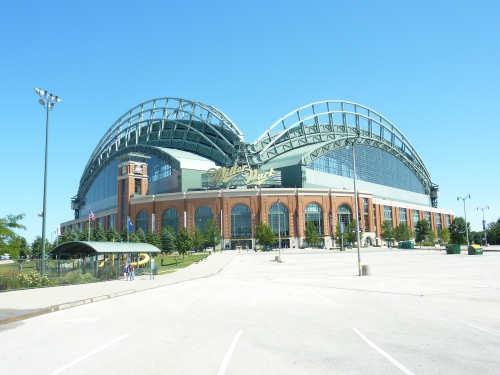
But as a ballpark, there’s not much positive to say. The form of outfield design serves only one function: to support the retractable roof. Most of the infield stands are covered, even when the roof is open. Note how disconnected the outfield fences are from the structure itself. Miller Park looks like it’s a stadium first, and the ballpark is an afterthought.
For most, the enclosed feel and lack of context is the main reason why Miller Park is thought of as one of the worst retro ballparks. But I’m not crazy about all of the games on the concourse, either. I’m not talking about the normal ballpark kid distractions, I’m talking arcade games, pinball machines, and those annoying stuffed animal retrieval prize games (claw crane). The word “mallpark” is thrown around too loosely in describing distraction-filled facilities, but Miller Park certainly fits the description.
But at the same time, the Brewers do a lot of random things well. This is the first review where I did the concluding bonus section first. The fan-shaped retractable roof is a novel engineering marvel, but it doesn’t do much aesthetically, so I can’t include it in interior design. The tailgating scene is awesome, but you can’t really include it in location. Crowding is nonexistent on the concourses, which deserves credit, but the concourse doesn’t utilize that space efficiently.

I do want to emphasize that the Brewers do the best job possible in representing Milwaukee, considering the insular nature of the building. The regional food is fantastic. The atmosphere is great. The ballpark many restaurants and unique bar areas. Also, it should be noted that the Brewers fans apparently love this place with much enthusiasm: on numerous occasions since 2001, fan polls have placed Miller Park near the top.
While because something is popular doesn’t mean its good, there is obviously a subjective quality to all this. And it’s mostly home fans voting on their own park in these polls. Isn’t all that matters is whether the people in their own ballpark like their ballpark? Perhaps. Most fans don’t travel and compare parks. But here that’s exactly what we’re doing.
The bottom line is Miller Park certainly adds something to the ballpark landscape because of its structural novelty and local flare, but with a suburban location, controversial exterior design, and perhaps the least aesthetically focused interior design in baseball, Milwaukee is inevitably in the nadir of the new parks.
Setting
Location/Access:
In a revenue-milking move for parking, Bud Selig insisted that Miller Park be located on the County Stadium site once near an uninhabited quarry, instead of downtown. Because of the tailgating tradition, I suppose this is the one ballpark where you can justify the suburban location.
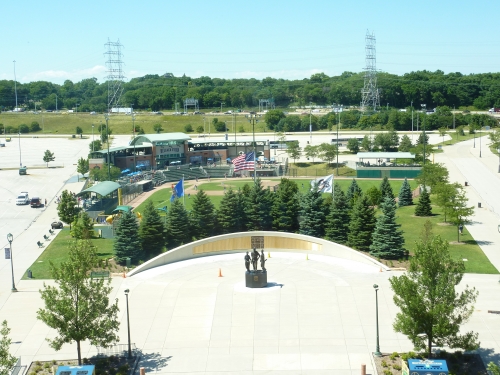
Despite the less than ideal placement, Miller Park is only 7 miles away from downtown, more easily accessible by metro transit than I would have ever thought. The ballpark is also adjacent to the interstate with easy access for cars. A massive array of parking spots lies beyond the center field panels, accessed by a lovely gate bridge, giving fans an immediate sense of arrival.
While there’s not much noteworthy about the location, the Brewers probably have the best situation amongst suburban ballparks, especially in terms of accessibility. But that’s like saying you have the best type of cancer.
Score: 2.5/5
Local Scene:
While there’s obviously a ceiling on how good the local vibe can be when located in a suburban area, the Brewers do a great job by actually encouraging the tailgating tradition. Other than that, there are a few bars/restaurants that offer shuttle service to the ballpark.
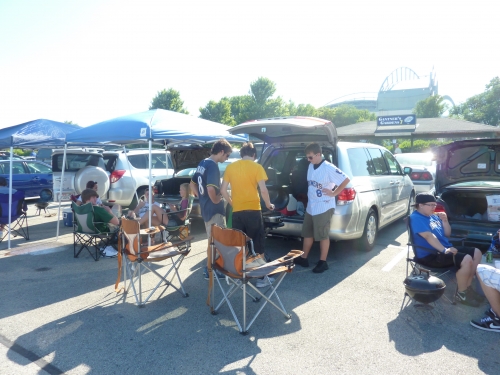
Score: 3/5
Total: 5.5/10
Architecture & Aesthetics
Exterior Design:
Easily the most controversial exterior design in baseball, many claim that Miller Park’s façade sticks out like a sore thumb among a sea of parking spots, or that the roof resembles a deformed tarantula. Despite any negative subjective assessments, Miller Park is the only retractable roof facility that attempts to have any kind of aesthetic integrity or structural elegance on the outside.
First discounting any criticism of the execution, I must point out that the red brick façade seems especially inappropriate here. From an architectural point of view, Milwaukee is generally known as the “Cream City” for its light colored clay brick, much of which is derived from the local area and Lake Michigan. But early on in the design stages, Brewers demanded an Ebbets Field inspired exterior façade.
Not only is the exterior a poor choice for the location, but it is also a poor choice when fused with an overwhelmingly large high-tech retractable roof. While it’s not as bad as Chase Field or Safeco Field, the Brewers continue to embody the stubborn retro insistence on combining modern technology with nostalgia. A modern treatment would have made much more sense.
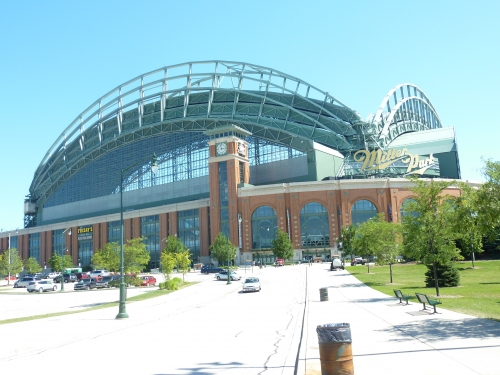
But Miller Park arguably does more things right on the outside than any other retractable roof ballpark in baseball. It still looks incongruous and a bit awkward, but I like how the wrought iron is more of a light faded green, evoking more of a worn, veristic appeal that fits the nostalgic treatment. The brick itself is fairly ordinary, characterized by an unusual amount of glass highlighted by the green iron, but it is slightly more coherent than the other retractable roof ballparks mentioned.
The majestic arches behind home plate serve as the focal point for the inward converging steel trusses of the fan shaped retractable roof. While a bit top heavy, the glass retractable structure itself is quite a marvel. Unlike the other ballparks, the Brewers emphasize presence rather than intimacy. The giant glass archways of the roof are nicely juxtaposed with the vertical glasswork beneath. The two glass roof arches successfully combine a nostalgic concept with modern application. Unlike retractable roofs in Seattle, Houston, and Phoenix, its moving ugly mechanisms are hidden inward, stressing Miller Park’s aesthetics.
However, as with every covered facility, its roof is disproportionately prominent on the outside compared to the superstructure. On the whole, it’s better than Safeco and Chase, but as you can see, that isn’t saying much.
Score: 5.5/10
Interior Aesthetics:
While Miller Park’s interior design has a couple of redeeming factors as a structure, I’m going to echo the consensus that the ballpark’s enclosed vibe doesn’t exactly scream old school baseball. But more importantly, there’s nothing here that attempts to have any kind of aesthetic attractiveness. Like Chase Field in Phoenix, form follows function, in what inevitably comes off as more of a multi-purpose gym than a ballpark.
Unfortunately, unlike Chase Field, this ballpark truly resembles a temporary diamond in a stadium, as the outfield unit lacks any sort spatial reasoning, appearing haphazardly constructed and disconnected from the main cross-section behind the infield. Simply put, there is some inherent tension between its cone shaped structural design, which facilitates the fan shaped retractable roof, and the need for an outfield for baseball. This isn’t conducive to quirky retro dimensions.

Miller Park’s saving grace is the novelty of its towering fan shaped roof, and its extremely impressive maneuvering of sunshine into the building.
My overarching impression of Miller Park isn’t entirely negative as a structure, but it certainly fails as a ballpark in terms of interior aesthetics. When looking at the outfield perimeter, I think that Miller Park is the least “aesthetically endowed” in the majors. There is simply no attention to balance, consistency, color scheme, or nature, in what is an overwhelmingly Spartan outfield setup. It should also be said that when the roof is closed, the outfield panels are not transparent, so the set up actually resembles a true dome.
First of all, Miller Park feels particularly claustrophobic in the outfield, as many have said. The black batter’s eye makes no attempt to add any aesthetic appeal. The color scheme of Brewer blue, faded green, and the gray in the support structure is particularly bleak. The sliding glass panels in the outfield are an admirable attempt to add some atmosphere to the ballpark, but they are largely overwhelmed but by the ads and the cluttered setup. It’s all just functional.
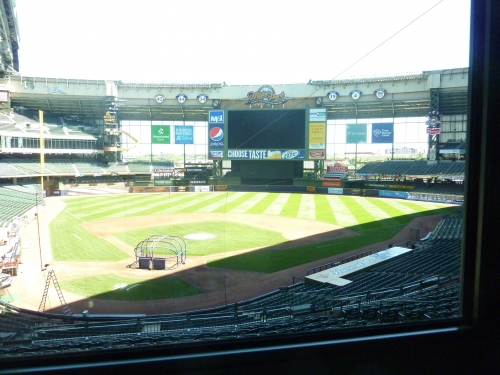
But the primary point you should take away is how the structure’s perimeter appears totally disconnected from the outfield grandstands and other elements. Note how poorly space is used and how disconnected all of the grandstands are from each other because of the conical shape beyond the outfield.
Miller Park appears to use an “outside-in” or additive construction method, where the structure is first conceptualized, and then the outfield seating/dimensions are built inside of it, in what looks like an afterthought. Scanning left to right, you’ll note a total lack of harmony between elements or aesthetic attractiveness. This results in what looks like a temporary structure, even though it’s actually not.
Case in point: Miller Park is the only ballpark in the majors where no outfield seating placed in front of the outfield wall, like the 70s cookie cutters. Note the wide separation in space between the outfield wall and the first level of seating. Why is Friday’s Front Row not at the wall? Look at how out of place the upper right field bleachers are situated in relation to the rest of the ballpark.
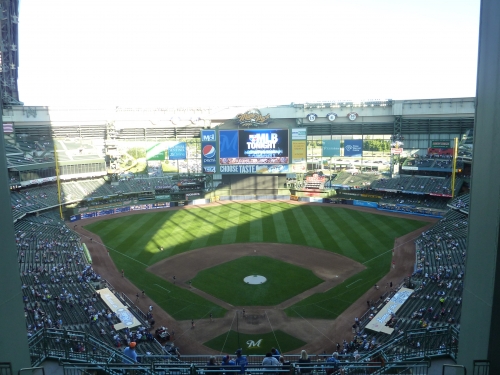
This last point is especially egregious in light of the asymmetrical dimensions and seating patterns. The building geometry is naturally symmetrical, but the dimensions are asymmetrical, stemming from a self-conscious effort to fabricate quirkiness, perhaps out of impulse. With no connection to the site, tension arises between the dimensions and the structural qualities of the building.
Note how disconnected the supplementary elements are from each other as well. I really don’t like the addition of the “Harley Davidson Deck” or the “Toyota Territory” seating, which further compounds the spatial issues and clutters the ballpark, while reinforcing the “temporary seating” motif in the Brewers outfield. It also took away some nice standing room only areas. I generally find that the number of seating areas randomly added as an afterthought is inversely correlated with the quality of the ballpark.
The disastrously gimmicky and overtly corporate “Bernie’s Dugout” is not only completely out of place with the rest of the ballpark, but a tacky disservice to a formerly nice tradition.
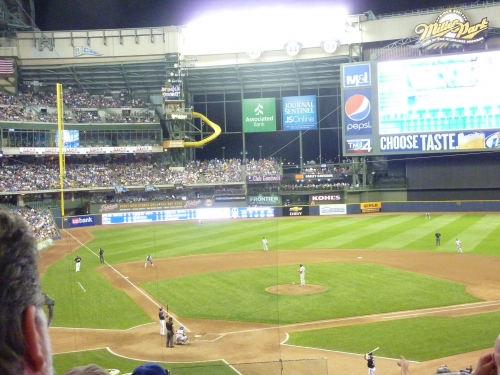
On the whole, it looks like they built the structure first, then put a ballpark inside of it. It all adds up to something that looks like a giant afterthought and an aesthetically boring stadium.
I also don’t get how a ballpark with 42,000 seats can lack so much intimacy, especially compared to a more intimate (similar capacity), retractable roof facility like Minute Maid Park. This might be the most overlooked flaw at Miller Park.
The park’s structure does have some redeeming qualities. We often judge the best/worse retractable roof ballparks by how they feel when open around the outfield. While Miller Park always suffers from a lack of connection to the outside (and when closed looks like Tropicana Field in the outfield), it does a masterful job in allowing natural light to seep in while closed around the infield. While Safeco Field gets so much credit for its design, they can’t say that.
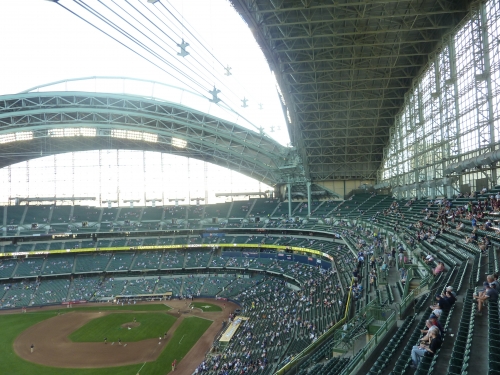
Even when the roof is shut, light effectively penetrates in from three separate directions. The only impediments are the massive glass arch windows on each side, which instantly makes Miller Park one of the most unique structures in the world. Imposing in both size and scale, it’s the one part of the facility that successfully fuses a nostalgic concept with modern application. Many overlook the fact the Milwaukee’s fan shaped roof isn’t too invasive as well. Unlike Safeco and Minute Maid, you don’t see an eyesore when looking up in right field.
So while I’d say its outfield aesthetics are easily the worst of the post 1991 ballparks, Miller Park’s structural elegance and inevitable novelty prevent it from being the clear worst overall in this category, even though it will certainly compete for the bottom spot.
Score: 7.5/15
Panoramic View/Backdrop:
Bleh. What can we say here? As I said, while the overall interior aesthetics aren’t clearly the worst overall of the post-1991 ballpark, I think the outfield aesthetics are.
If the ballpark is closed off from its environment with no regard for aesthetics, the interior design is compromised. Again, this is the inevitable penalty for simply being functional on the inside, with no aesthetic purpose. Why not make the outfield panels transparent when closed, like Minute Maid Park? When Miller Park is closed, the outfield set-up basically looks like Tropicana Field.

Score: 1.5/5
Concourses:
Aesthetically, the concourses are particularly undistinguished. I will say Miller Park comes off as more “mall-like” than any other park in the majors, and I’ve said the term “mallpark” is overused. Concession stands have neon lighting. On multiple concourses, we see prominent kids areas, restaurants, arcade games, pinball machines, and claw crains (those annoying toy retrieval machines). So in some sense, Miller Park may have the worst looking concourses for a ballpark.
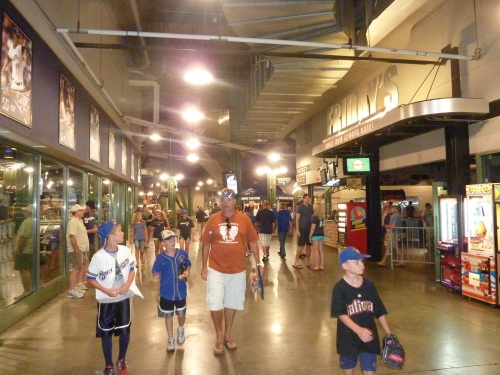
Score: 1.5/3
Total: 16/33
Functionality & Essentials
Sightlines:
While the seating angles are slightly below par, the main theme I take away about Miller Park’s functionality is the extremely poor field proximity from the upper decks.
For all you “ballpark hipsters” that dislike the architectural firm HOK (Populous), HKS has consistently failed to put fans on top of the game. Miller Park and Rangers Ballpark are the two worse ballparks in cantilevering the upper levels, instead opting for a “stepped effect.” Just take a look at how far back the decks are from the field, as the loge level isn’t at all hung over the field level. Virtually the same can be said about the club and terrace level.
Just compare it to another retractable roof facility, Minute Maid Park. I counted 47 rows in both the loge and field level at Miller Park; 40 rows at Minute Maid Park on the field level. At Miller, the club and terrace levels are only slightly cantilevered, to the point where I’d guess the first row of the upper deck is about 45-48 rows back from the field. At Minute Maid, the club level is cantilevered 12 rows over the field level while the upper deck is almost completely overhung over the club level. Do the math.
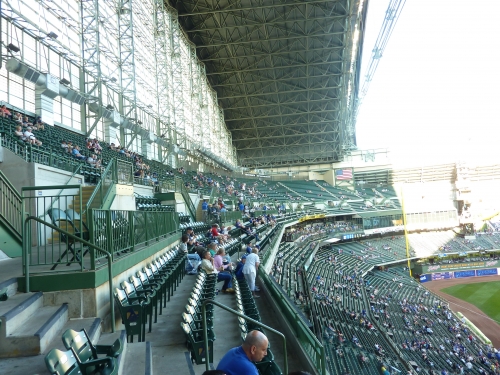
Yes, the first row in the upper deck at Minute Maid is 30 rows from the field while at Miller it is 45+ rows. That’s a pretty big difference.
So what’s the benefit of Miller Park’s approach? By not cantilevering the decks, it doesn’t make the upper deck quite as high off the ground. The more cantilevered the decks are, the higher they have to be to avoid overhang obstructions below. Because Milwaukee has four decks, not the usual three (plus small suite level), they had to mitigate the high upper decks by having no overhang. But because there are four decks, the experience is as high off the ground as any other ballpark, while again being further back.
Okay, so then why go with four separate decks? No deck is too large, thus eliminating the chances your view will be blocked by someone taller in front of you. With many of these 40 row lower decks in other parks, the slope is so low that the back of the box seating can sometimes be pretty poor. So that’s the main pro I see.

Still, like most people who have looked at this closely, I think the Brewers deck mechanics are inferior.
The seating geometry of Miller Park down the lines is somewhat inadequate as well. Like most ballparks, there are too many instances down the lines where you’re going to have to turn your head, especially in the certain sections of the upper deck. Miller Park’s right field upper deck is especially problematic.
It is hard to believe, but Miller Park was planned to have FIVE decks, including a separate suite level, according to a newspaper article in the Milwaukee Sentinal in the 90s. It would have had a field level, loge level, club level, separate suite level, and terrace (upper) level, making it easily the highest ballpark in the majors. They smartly opted to combine the club and suite level to cut down on costs, even though their four deck approach is still too spread out.
Score: 7/10
Seat Comfort:
Despite the large seating bowls, the seats at Miller Park feel particularly narrow. Sitting in the loge level, I felt the foot room and seat width was slightly below par compared to other parks. But it’s not a big deal and not significantly different from other ballparks in the majors. PNC Club level seats are the only padded general seats in the stadium. At least as of 2011, the upper deck seats lack cup holders, and that’s just no fun.
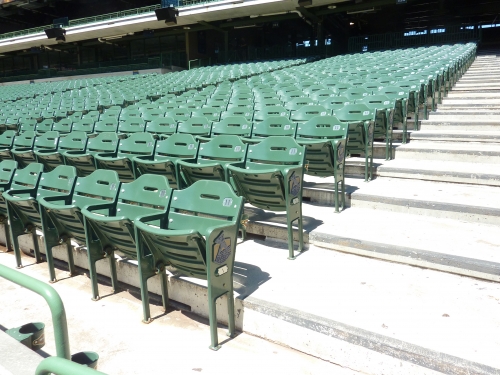
Score: 3/5
Concourses:
Miller Park’s concourse situation is a bit of a paradox, as the facility is built on a sprawling vertical footprint eliminating any potential crowding, while the execution in concourse circulation is poorly articulated, albeit quite novel.
Like Turner Field in Atlanta, Miller Park has four distinct concourses instead of the usual three, meaning that you’ll rarely get in much of a bottleneck. Multiple huge concourses on both the field and loge level easily accommodate the maximum number of fans. The upper deck concourse also has an unusual surplus of space. Note the dead area in the far left and right field corners of the upper deck concourse. The Brewers also provide four separate levels, meaning that the concourses are open on the loge level and partially open on the field level.
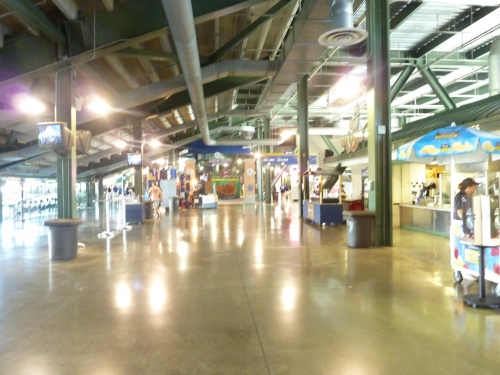
Despite having no spatial constraints, the field level concourse suffers from a number of logistical flaws. While there are no vertical discontinuities, it feels more like a maze than any concourse I’ve ever seen. While more of a shortcoming than a design flaw, visibility of the field is obstructed by suites on the main concourse for the first 100 feet down both the first and third base lines. In between the two suite structures, there is a large food court behind home plate open to the field.
Throughout the rest of the main concourse, there seems to be constant interruptions in continuity. Past both the first and third base bags down the lines, there are random circular concession stands that split the main concourse into a dual system. It is an interesting approach that facilitates visibility of both the field and the area outside of the stadium, but it is unnecessarily cumbersome and not necessary for a suburban park.
Further down the right field side, the concourse continues to be impeded by a giant kids zone. I don’t know why this has such a prominent presence in the ballpark. In the left field corner, we have the same effect by a team store. The entire system is difficult to navigate.
The outfield concourse is especially lacking, failing to promote 360-degree circulation. We see ballparks in Philadelphia and Washington that encourage the fan to walk around and explore all areas. Originating in Camden Yards and Jacobs Field, most retro parks have well thought out standing room only areas in the outfield. Instead, Miller Park’s outfield concourse is completely ignored. No concession stands. No wide areas of congregation. It looks more like an obscure hallway that deters fans from walking around the ballpark. This is a major no-no.
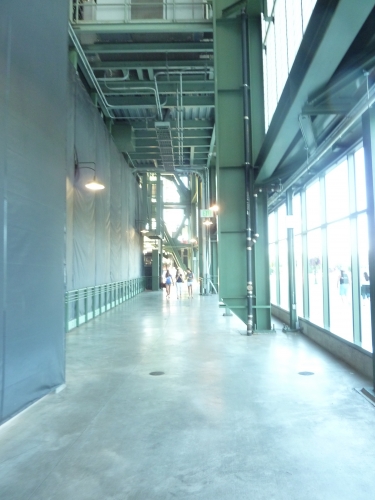
Score: 4.5/7
Scoreboard System:
During the 2011 offseason, the Brewers became the latest franchise to install a new mega video board in their ballpark. Measuring 5940 square feet, it is the 5th or 6th (depending on the source) largest board in the majors for the 2012 season. It is as informative as any, showing both lineups and pitching info in crystal clear quality. It is one of the few to be 1080i as well.

Score: 2.5/3
Total: 17/25
Amenities & Features
Quality and Selection of Concessions:
While generally having a reputation for focusing on a few high quality items, Miller Park has a surprisingly nice selection of food for such a small market. In the famous Sports Illustrated ballpark rankings poll, Milwaukee’s food was rated the best in baseball. So in terms of fan satisfaction, Miller Park is number 1. Not much of a surprise there.
Traditionally, the Brewers have focused on their selection of sausages, sampled with the famous Secret Stadium Sauce. But lately, Miller Park has been serving some surprisingly trendy items. They excel in providing some off beat healthy items, like apples, organic fruit, chicken Caesar salad, and hummus. The Java coffee cart has an excellent selection of beverages, including delicious coconut, caramel, and toffee frappe freezes. Blended fruit and cream drinks, along with smoothies and Italian soda, round out the list.

Miller Park also has a nice selection of subs and sandwiches. Italian beef and Turkey Club sandwiches highlight the list, accompanied by multiple deli wraps, including ham and veggie. The Brewers also have a surprisingly good selection of Mexican food. Loaded pork, beef, and chicken burritos are served with the works at special kiosks. Specialty nachos, tacos, and Mexican salads round out the fare.
While “BBQ” is randomly printed on the circular concession stands, this isn’t a ballpark known for BBQ. Recently, they opened a BBQ sausage slider cart, which serves smoked turkey and brisket. Ribeye steak sandwiches are found in the Plaza Pavilion.
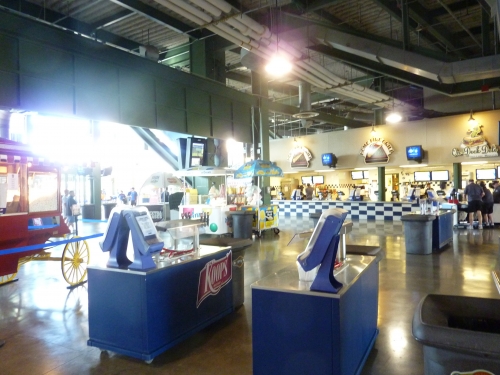
Scrumptious potato dishes are also of note. Multiple types of “pommes frites,” a salute to the French up north, are served with specialty dipping sauces. Taking a page from their division rival in Houston, giant baked potato plates are available as well, including BBQ, broccoli and cheese, taco, and chipotle chicken.
While Miller Park has recently picked up its selection, the ballpark is more known for its local specialties than its international fare or mall-like variety.
Score: 4.5/5
Regional/Signature Concession(s):
It took me a long time to bump Milwaukee up to a perfect score in the signature food category, because they don’t have local eateries. But they have some items that are on par with the Rocky Mountain Oysters in terms of novelty. And that’s really saying something.
The reason for the high fan satisfaction is the focus on providing a unique local flare. But unlike some other big metropolitan areas, Milwaukee is radically different from the rest of the country. Traditionally, it’s been the classic brat and the famous Secret Stadium Sauce that has gotten the headlines, but there’s much more to be discovered at Miller Park.
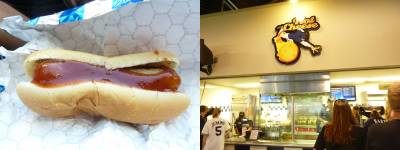
The Wisconsin Fish Fry mixed in with the regular concessions is a particularly nice touch. The dedication in providing a number of unique cheese specialties deserves credit as well. Virtually unheard of in the south, the “cheese curds” definitely set the menu apart, and they are only available at a few ballparks up north. Miller Park also serves multiple grilled cheese sandwiches, including a specialty one with avocado aioli, pico de gallo, and Wisconsin sharp cheese.
But one of the most distinctive food specialties I’ve seen at any ballpark in America is the poutine. A reference to Montréal, poutine is a decadent fresh fry snack topped with heavy beef gravy and cheese curds. Now that’s something you will only see at Miller Park!
Score: 2/2
Accessible Restaurants/Bars/Sitting Areas/Social Spaces:
Miller Park has plenty of bars and sit-down areas on the concourses to relax.
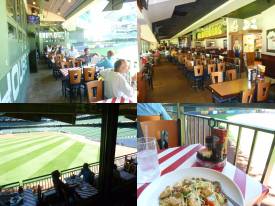
First of all, Friday’s Front Row restaurant is one of the closest public eateries to the field in baseball. While serving predictable American casual food, Friday’s is located only feet from the grass below the loge deck in left field. No special entry privileges are required to dine here, including the outdoor patio. A number of other random watering holes are located all around the ballpark.
Friday’s Beer Garden and the Plaza Pavilion are two other sit down areas located on the main concourse. While easy to miss, the Loge Bar and the Terrace Bar provide their respective levels with a place to chill as well.
However, Miller Park hasn’t added the new, trendy social spaces of other ballparks in the 2010s.
Score: 3.5/5
Premium Seating/Clubs:
In some circles, Miller Park should be highly acclaimed for having the most egalitarian seating arrangement in baseball. It’s the only park in the majors where there is no club seating on both the first and second levels. As the smallest market in baseball, Milwaukee certainly offers less than the average baseball city, but it has some thoughtful features nonetheless.
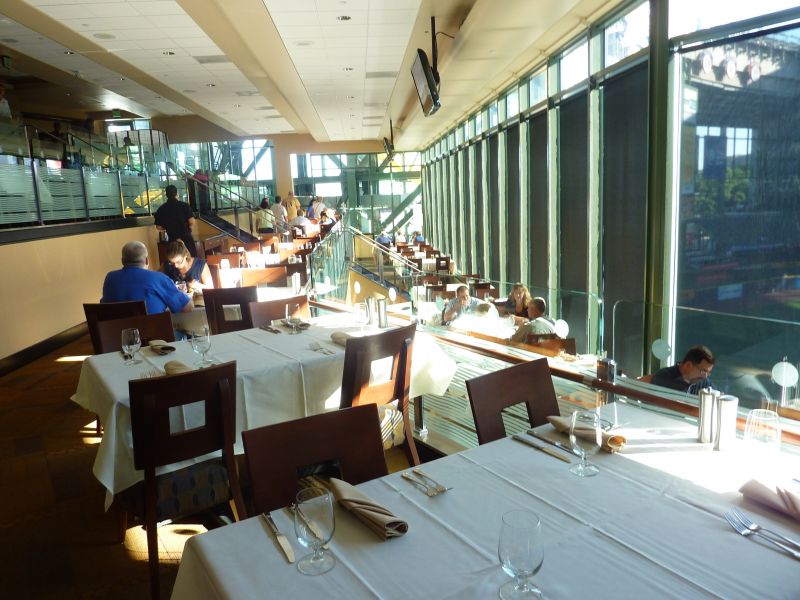
I guess I’ll start off with the lavish club restaurant, which I never do. The NYCE Stadium Club is clearly the focal point of Miller Park’s premium presentation, as the Brewers don’t offer any true high-end corporate club seating. Considering this, Milwaukee made a special effort to provide one of the nicest white tablecloth dining experiences in the majors. The décor is quite conventional, but among the most luxurious nevertheless. The food presentation is superior as well; the buffet is $39 compared to the usual $29 you see around the league. I was especially impressed with the fact they have informal outdoor patio seating for those who want to dine cheaper outside.
The PNC Club Level comes off more as a suite level hallway that happens to have club seating than a true premium space. It’s the highest club level in the majors as well, located far back in the seating area on the third level. Articulated with dark oak wood paneling and navy blue carpet, the home plate lounge is the only area that provides significant amenities, such as a bar and plastic table seating. Note that the ceiling leaves pipes exposed as well, so it really lacks in luxury.
While the Brewers offer no super premium options behind home plate, the Gehl Club on the third level provides a luxury all-inclusive option. Miller Park doesn’t blow you away with the premium options, but they do a good enough job in satisfying their market.
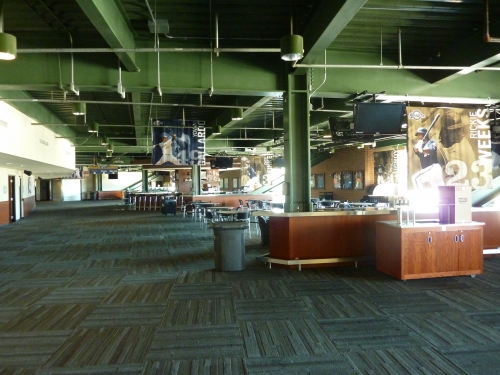
Score: 3/5
General or Artistic References to Baseball or Team History/Museums:
Despite lacking a museum with all the space they have, nor honoring Brewers history on the concourses with banners, Miller Park does an average job in referencing team history.
Milwaukee has a relatively well thought area in the left field “hot corner” called the “Walls of Honor”. The enclave includes information and memorabilia on the Braves, Brewers, and County Stadium. The walls pay special tribute to the history of baseball in Wisconsin and women in baseball. The nearby Autograph Alley is a collection of 100s, maybe 1000s, of baseballs with signatures from Brewers greats. There is also a plaque area known as the Milwaukee Braves Honor Roll.

On the outside, the Wall of Fame commemorates the best Brewers in history. Each player is honored with an engraved granite home plate outside the park, further signaling that Miller Park wants to be known for its exterior. It loosely resembles the Hollywood walk of fame, unique for a ballpark.
Miller Park also includes a number of statues and plaques on the outside. By the mega little league park known as Helfaer Field, there is a stone exhibition honoring the 1957 World Champion Milwaukee Braves. This is another piece of history you would usually see inside the park, but the Brewers choose otherwise. In addition to statues of Hank Aaron, Robin Yount, and Bud Selig, there is an effusive display for those who built Miller Park. In addition to the teamwork statue featuring the three workers who died, there is the prominent “heroes” plaque area behind it, presenting the names of each worker who contributed.
Score: 4/5
Entertainment/Kids Activities/Other Amenities:
Instead of providing the usual specialty kids area, tucked away from most of the baseball fans, the Brewers really knock you on top of the head with it. While obnoxious and resulting in particularly mall-like concourses, Miller Park may score highest in the majors here.
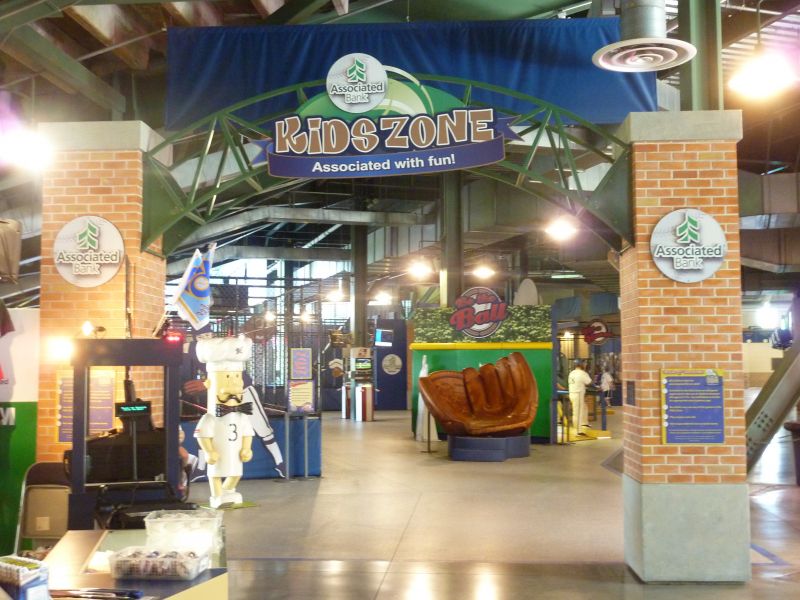
The extravagant “Kids Zone: Associated with Fun!” (seriously?) consumes an alarming amount of space on the first base/left field main concourse. All of the usual suspects are included, such as trivia games, virtual base running, batting cages, and speed pitch. The Great Sausage Race actually seems pretty cool. There’s a video game station sponsored by U.S. Cellular behind home plate. The Bernie’s Dugout kid’s slide is a great idea as well, where kids can slide down just like the acclaimed mascot.
But it doesn’t stop there. Miller Park is the only ballpark where the kids’ activities creep into the upper deck. There’s no escaping it! On the terrace level concourse behind home plate, a giant jungle gym called “Bernie’s Clubhouse” takes up much of the area.
The Brewers started another bad precedent as the only ballpark I’ve seen with arcade games, as I have already mentioned twice. And they really seem to be wherever you look on all 3 main levels.
Score: 3/3
Total: 20/25
Atmosphere, Vibe, & Policies
Atmosphere/Fan Support:
Despite being chastised for the financially indulgent nature of the project, Bud Selig said Miller Park would save the Brewers. With all its extravagance, it would put Milwaukee on the map. Well, 10 years later, Bud turned out to be right. The good team on the field didn’t hurt either.
Milwaukee is baseball’s smallest market, but appears to have sufficient financial leverage going into the next decade due to a dedicated owner and a supportive fan base. No longer is Miller Park the Cubs’ northern timeshare. The Brewers have drawn over 34,000 per game in each of the past 5 years, including 37,000+ in 3 of them. Discounting the year following a 56-106 record, the fans have been impressively loyal throughout Miller Park’s lifespan.
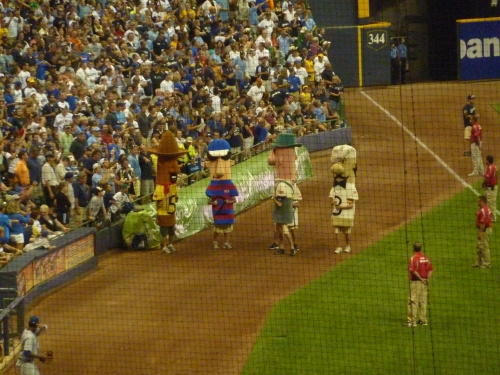
I would be remiss if I didn’t also mention the particularly unique atmosphere at the ballpark. When in Milwaukee, you’re going to witness a very distinct cultural vibe among the fans. It’s hard to put a finger on it, but it’s truly unlike any other place in the majors. The Brewers bring a number of unique customs to the table, namely the famous sausage race and “Roll Out the Barrel.”
The Klement’s Sausage Race is an event held at the bottom of the sixth inning where themed sausages race on the field. Originating in 1994, the sausage race has since become a significant part of Brewer lore. The concept has been copied by a number of other teams, adjusted for regional appeal (think Nationals’ Presidents Race). Considered the unofficial state song of Wisconsin, “Roll Out the Barrel” is played during the 7th inning stretch, in a solute to the city’s beer-making heritage. Bonus point later for the cool traditions.
Score: 4.5/5
Ballpark Policies/Customer Service:
From what I have read, Miller Park has the reputation of being the “mom and pop” type of ballpark, where the ushers and customer service representatives try to cultivate a local family oriented environment where everyone knows each other. While I only attended one game, I saw nothing that would refute that.
On paper, it is very fan friendly as well. This is one of only a small handful of parks where any fan can walk right up behind home plate before the game unencumbered by premium club sections or overreaching ushers. Autographs are easy to come by. Miller Park is one of the only parks I’ve seen that give out a free game day program, in an effort to continue its value friendly appeal.

Score: 2/2
Bonus:
For building an engineering marvel in the fan shaped roof +1
For exceeding every other ballpark in terms of kid related games and entertainment activities +2
For representing the city and having the most unique team traditions in baseball: “roll the barrel” and the sausage race +2
For the most egalitarian seating arrangement in baseball +1
For the terrific tailgating scene +1
For building a ballpark with perhaps the biggest footprint in baseball. Specifically note the number of bars and sit down areas +1
For Helfaer field, the largest little league ballpark outside of Williamsport +1
Score: 9
Total: 15.5
Conclusion
While not as nice as some of the newer retro ballparks, nor as aesthetically endowed as its retro-classic predecessors, Miller Park manages to avoid the “take or leave it” quality due to its structural novelty. It scores in the nadir of retro ballparks due to its inferior interior design, suburban location, and various objective flaws, but manages to represent the region. And in the long run, the latter factor is what matters. Milwaukee loves it and it’s different.
I say all of this because I like to estimate which ballparks of the era will be the next Fenway Park or Wrigley Field, and which won’t last 30 years. It’s been 20 years since Camden Yards, and the modern Marlins Park is opening this year, so we need to start considering the effect of the waning support for the retro aesthetic.

In theory, if red brick and neoclassical architecture is ever as hated as much as the cookie cutter concrete, Miller Park will be the first to go, considering the inevitable decline in the functionality of the roof and the location. Trends die.
Luckily, I think Miller Park avoids this in reality due to the aforementioned reasons, especially all of the local love it gets. Despite scoring the second lowest of all ballparks that opened since 1991, it brings something unique to the table, and that’s more than Turner Field or some of the newer parks can say, despite those parks being better.
FINAL SCORE: 74.5
RANKING: #24/30
Summary
TL;DR? Here’s the long-form piece in a nutshell:
Notable for its fan-shaped retractable roof, there’s a striking divergence of opinion on Miller Park between locals and ballpark enthusiasts. Brewers fans have perhaps the strongest bond to their home park of any fanbase outside of Chicago and Boston, while stadium aficionados generally rank Miller Park toward bottom of the middle, often bottom 10.
I’ve always been particularly harsh on Miller Park, which is curious given how much fun I usually have here. So much of the intangibles of a Brewers game—the awesome fans, the Milwaukee vibe, the unique ballpark traditions like the Sausage Race—are delightful. But Miller Park falls short in virtually all other facets.
The tailgating experience is fantastic, but Miller Park is a classic “parking lot stadium,” and I’m always on team downtown baseball. I don’t like the exterior’s gargantuan profile that screams “small town trying to be prime time” or its red brick facade, out of place for the non-urban setting, city, and roof technology. Strong Elroy Jetson’s hat/Queen Victoria’s dress vibes! I don’t know, there’s a certain structural elegance to it, and the roof has some subtle design elements compatible with the brick below, but it screams Steampunk.
Inside, the park feels dramatically overscaled. Even when the roof is open, the park feels drab and enclosed. When the roof is closed, outfield panels let in no natural light. Compared to retractable roof parks in Seattle and Houston, there is no visual sense of place here whatsoever, and it particularly lacks intimacy for only 42,000 seats. Overall, the architecture inside and out does not reflect the city, independent of its unwieldy aesthetics.
Miller Park isn’t a particularly functional building for watching baseball. All modern-day ballparks have upper decks too high and pushed back, but Miller Park is the worst offender, with four decks and little overhang. The seating geometry can be problematic. Seats in the upper deck lack cupholders, a rarity. The main concourse is difficult to navigate with many confusing diversions and horizontal discontinuities. The outfield concourse is barren and narrow.
There are some bright spots—a massive craft beer wall, the new left field brewery, and a (*checks notes*) new virtual golf zone—but even the amenities aren’t great.
This is a comparative exercise—all modern-day baseball-only venues are fine, including Miller Park—but I just don’t see how Miller Park compares well objectively speaking. I love the atmosphere, but it scores dead last among post-Camden (post-1992) MLB ballparks not due for comprehensive renovations or replacement.
Defining Features
Fan-Shaped Retractable Roof

Bernie's Chalet
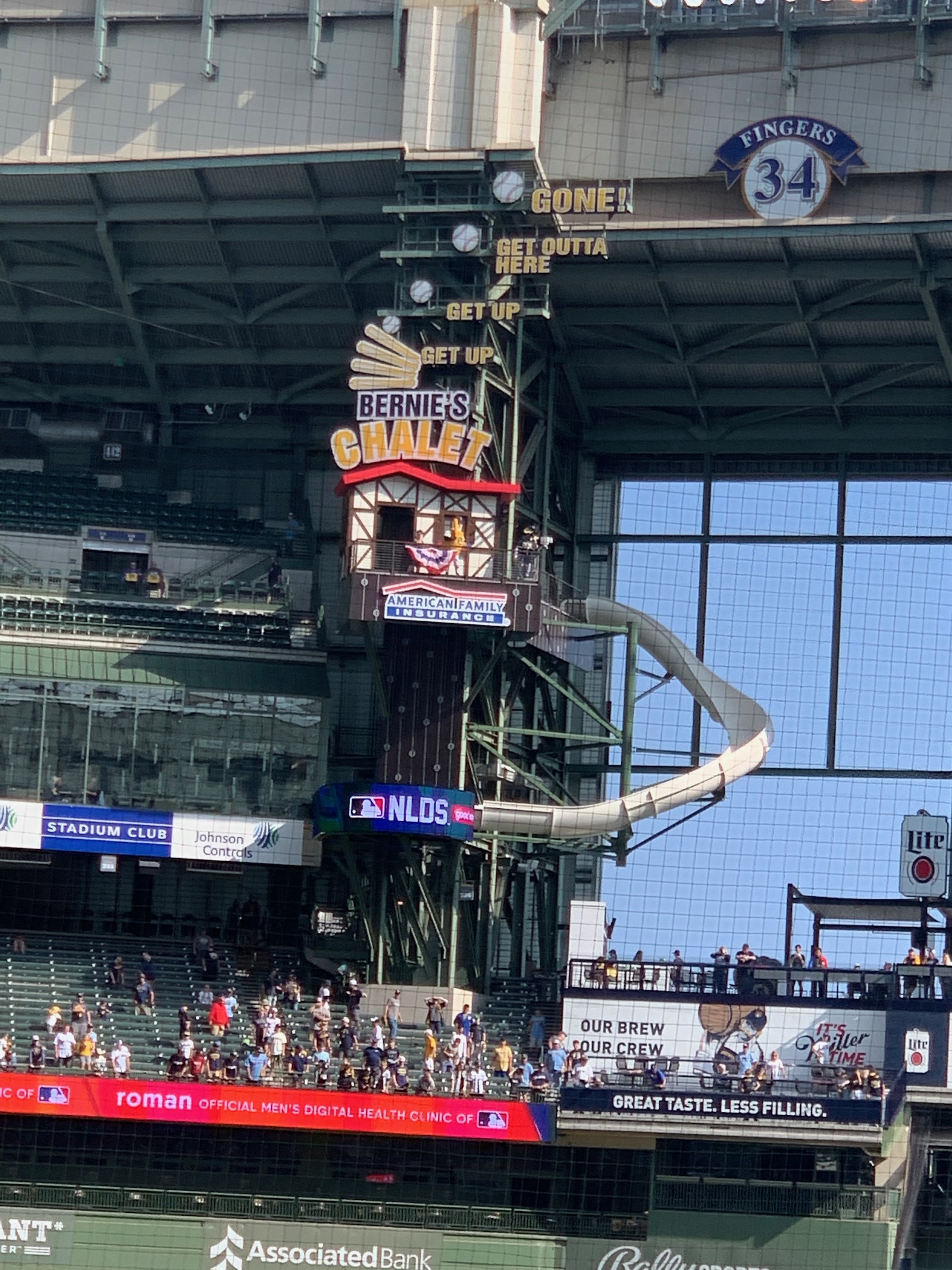
Biggest Hit
Distinctive Milwaukee Vibe
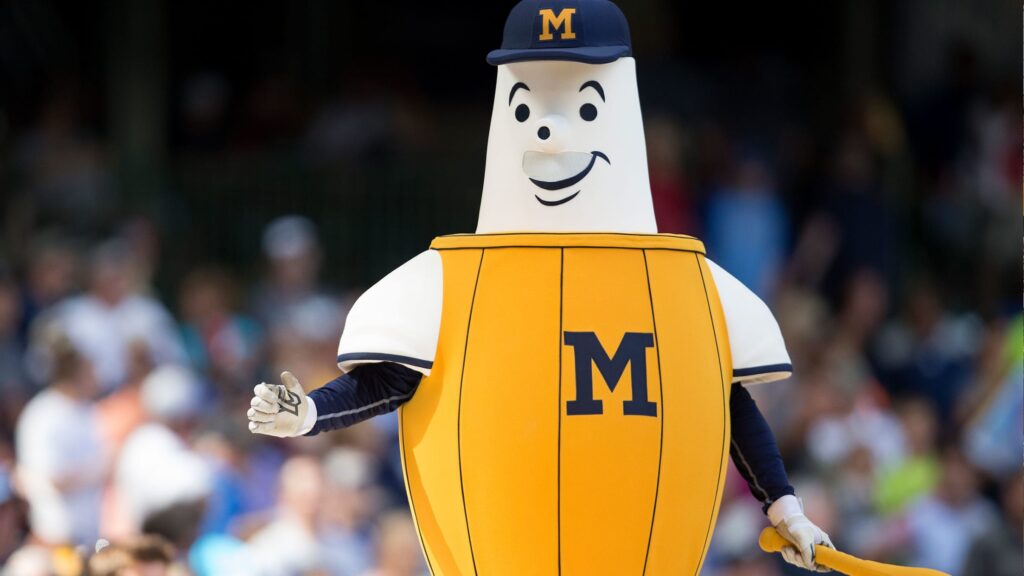
The interior visuals don’t let you know where you are, and the architectural materials don’t reflect the city, but the venue formerly known as Miller Park has always possessed that indelible Milwaukee sensibility. Consider: (a) it’s the only MLB ballpark where brats outsell hot dogs, (b) the tailgating tradition is unlike anything in MLB, more resembling a football game, (c) the concessions serve quirky Wisconsin specialties, (d) the Milwaukee beer is increasingly regional, and (e) the Famous Racing Sausages and the Beer Barrel Polka are iconic Brewer traditions.
Biggest Miss
Upper Deck Pushed Back Too Far From the Field
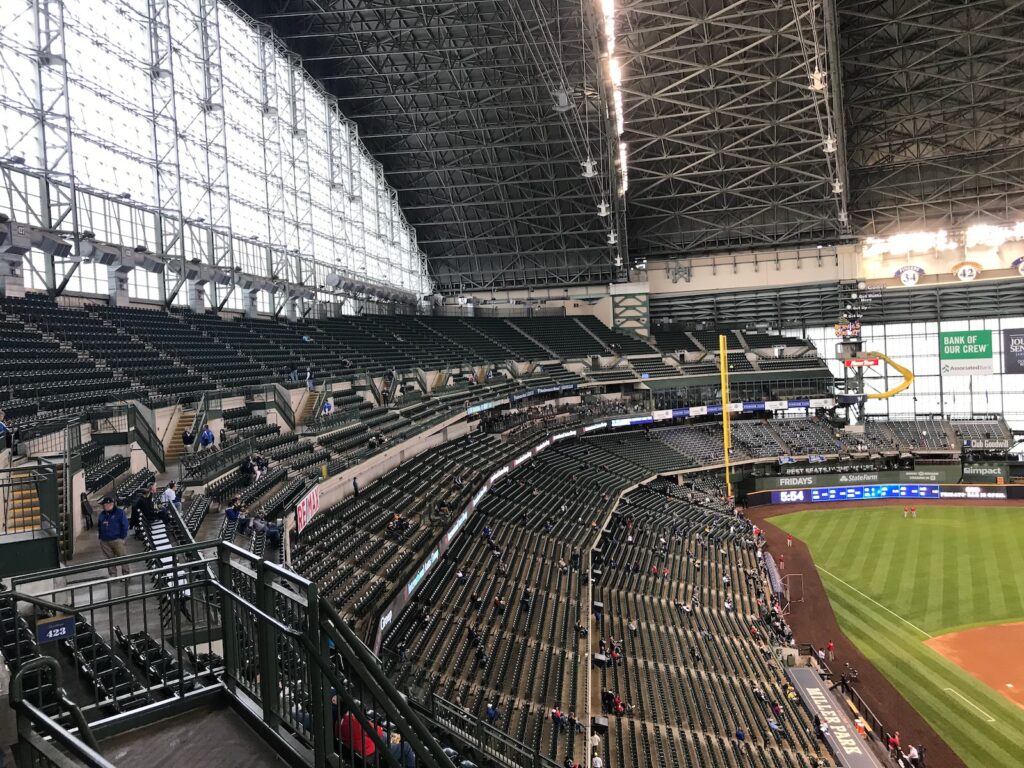
Poor field proximity from the upper decks is the biggest flaw of the “new” post-1990 ballparks. The average fan is pushed farther away compared to the classic parks. Miller Park is the worst offender. With four decks and little overhang, Miller Park opts for a “stepped effect,” pushing fans in the upper deck far from the action. Between the field, loge, and club level, the first row of the upper deck is horizontally 45-48 rows back from the field. I get into the weeds of how poorly this compares in the body of this review, but suffice it to say it’s not good.
Other Hits
Best Tailgating Scene in Baseball

More resembling the scene outside of a Packers game than anything in MLB, the Brewers’ tailgating scene is baseball’s largest outdoor pre-game party. A Milwaukee institution.
Architecturally Novel Structure
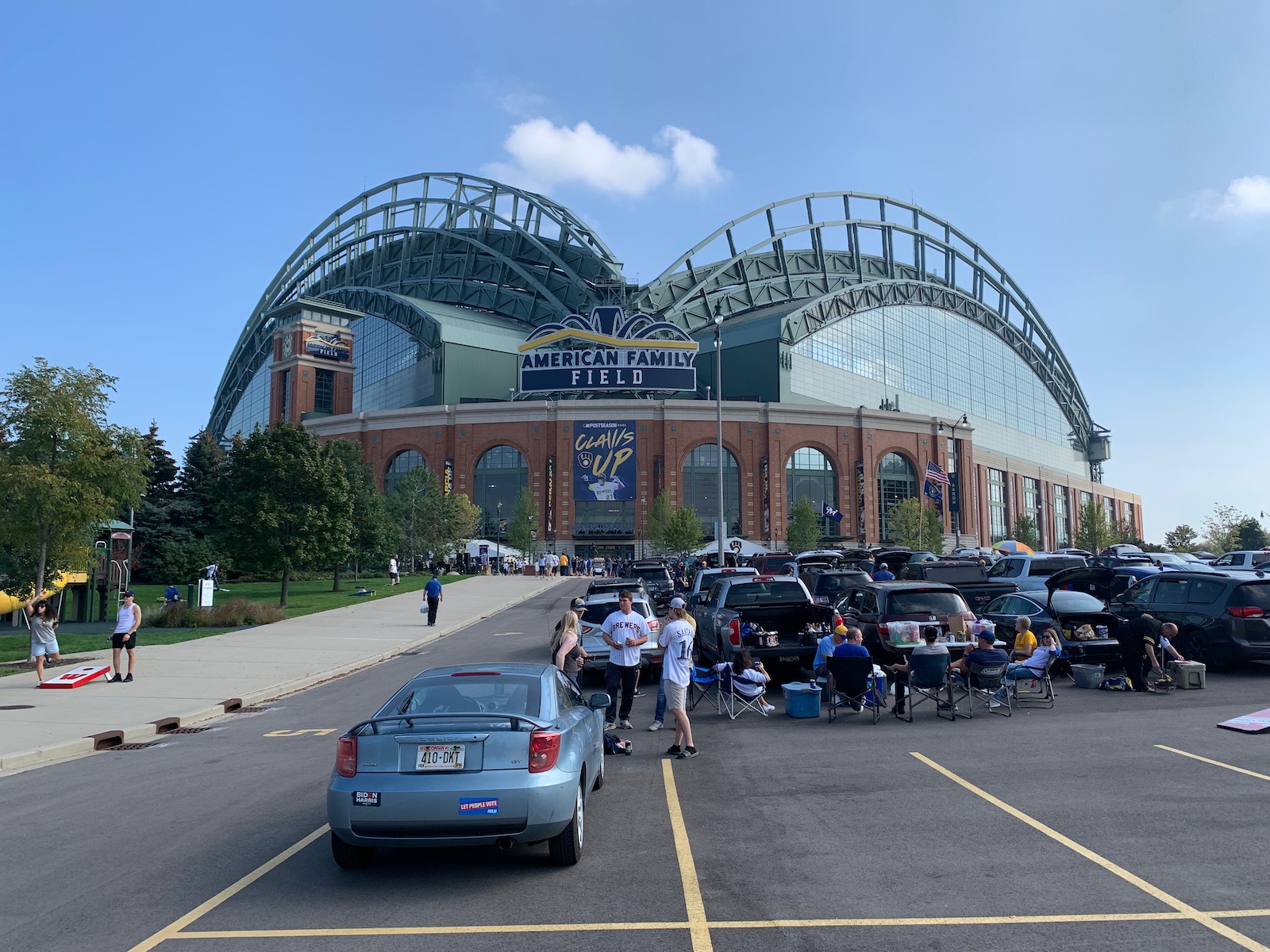
Say what you will about Miller Park’s architecture, but it’s not one of those generic cookie-cutter retro parks you’re likely to forget on your ballpark tour. It may not match my tastes, but it’s certainly distinctive. The sprawling fan-shaped roof is one of a kind.
Renovated Main Concourse Concessions

2017 brought a much needed overhauled concession design with refreshed signage. Gone are those dull green circular kiosks splitting the concourses, in are “Wards” down the first and third base line, anchored by giant locally-inspired bars. A huge upgrade in terms of functionality, aesthetics, and offerings.
Egalitarian Seating Setup
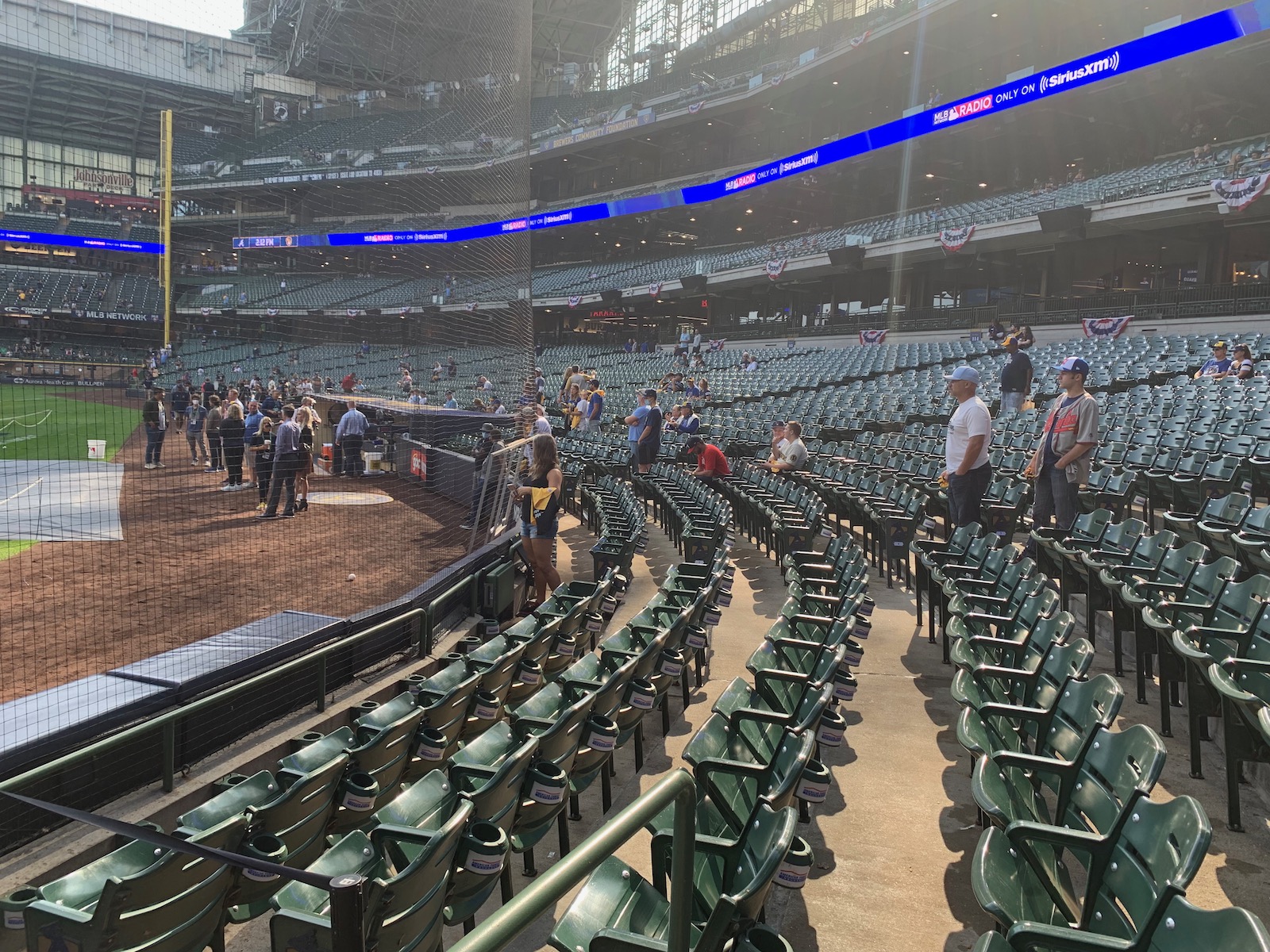
Partly a function of sitting in baseball’s smallest market, Miller Park is one of two 21st century MLB parks without a VIP “home plate club” in the first rows of the lower level. Moreover, it’s the only MLB park with any club seating in the both the first and second level. The means average fans can sit close to the action at relatively reasonable prices.
Impressive New Social Spaces: Barrel Yard Brewery and Virtual Golf Zone
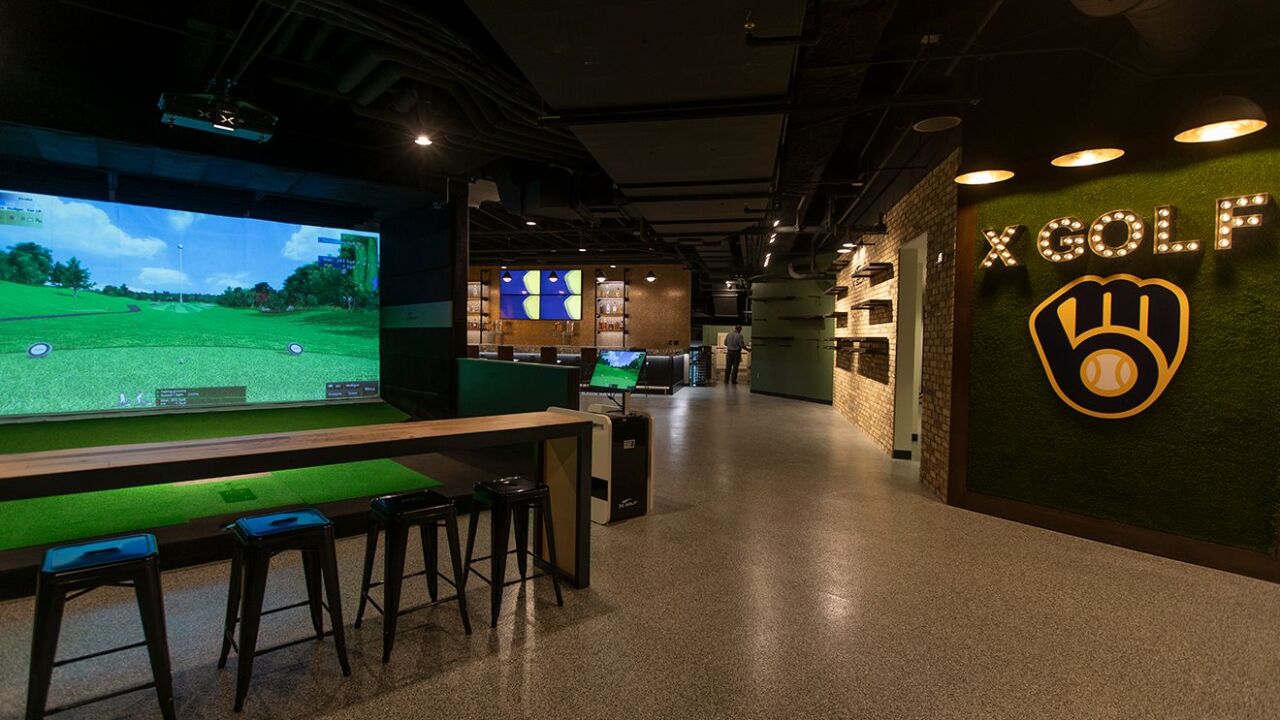
Before 2021, Miller Park’s amenities were weak in all facets. In particular, its restaurant and social space scene was defined by a passe TGI Friday’s and an outdated Stadium Club. A new brewery will be added in the former’s spot in 2023. A virtual golf zone with field views displaced the latter in 2022.
Brats with Stadium Secret Sauce

Dating back to the County Stadium days, Milwaukee’s brat with Secret Stadium Sauce was one of baseball’s original “signature foods.”
Craft Beer Wall

Capitalizing on the stadium craft beer wave, a Local Brews bar added in 2017 sits on the loge concourse down the right field line. What I love about this one is the amount of quality local suds on tap, as canned craft beer is more in vogue for various reasons (see White Sox Craft Kave).
Ballpark Traditions

Shortly after debuting in the early 1990s, the Sausage Race became baseball’s famous in between inning entertainment. The concept has since been copied by many MLB teams. The Beer Barrel Polka, a drinking song recreated as homage to Milwaukee’s beer culture, plays after the 7th Inning Stretch.
Bob Uecker Statue at the Top of the Upper Deck

klkl
Robust Fan Support for Baseball's Smallest Market
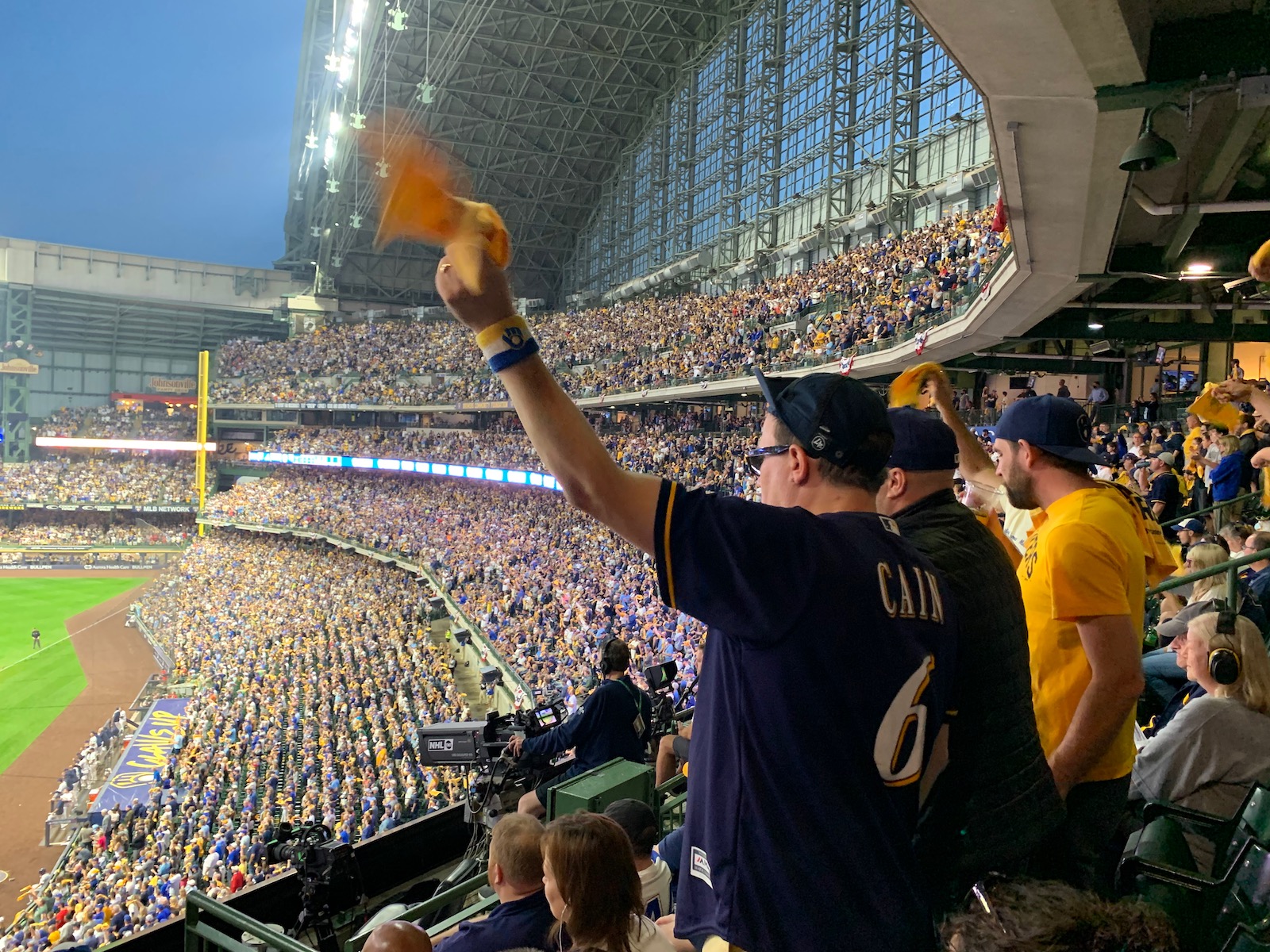
Helfaer Field
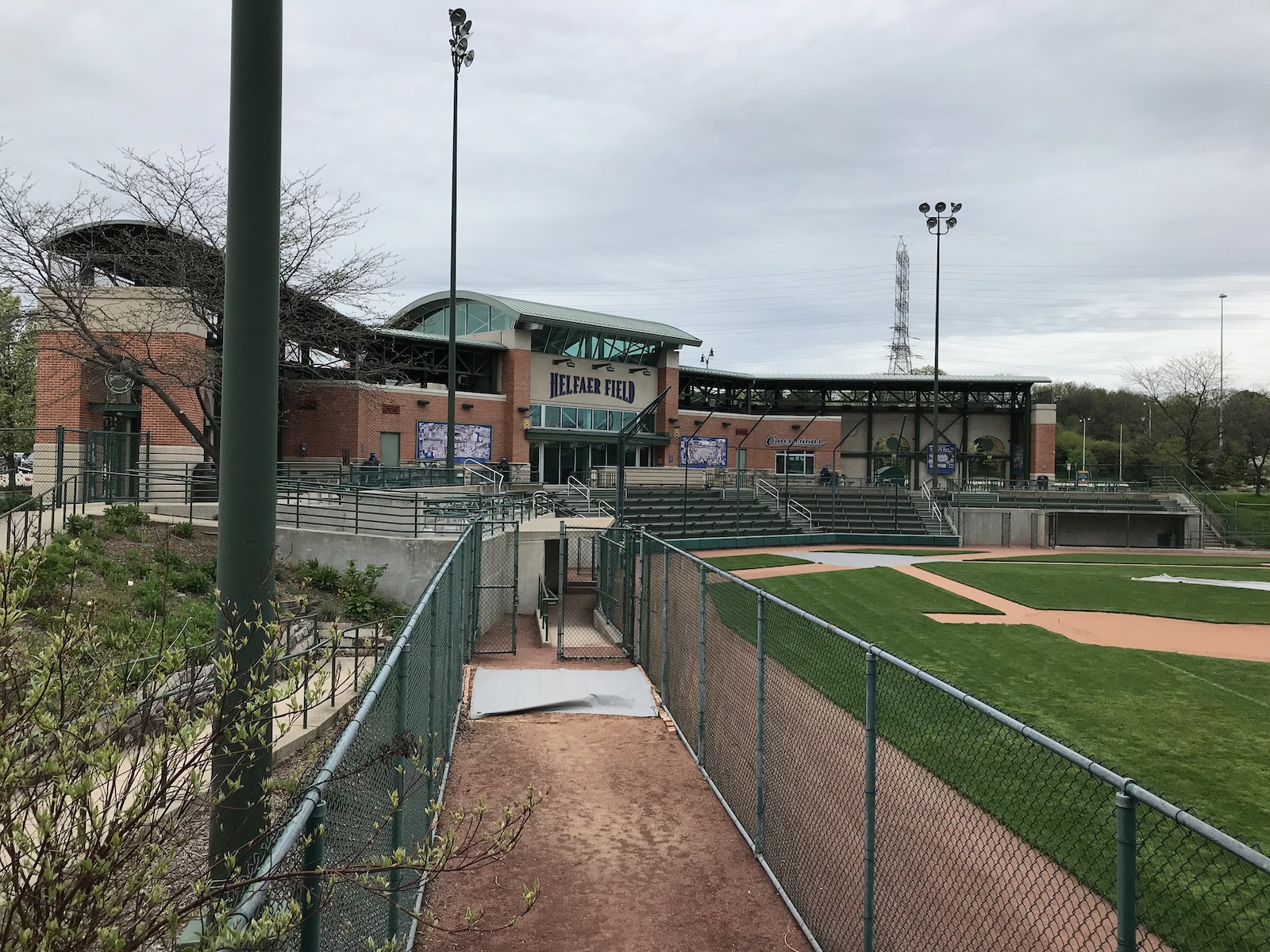
Other Misses
Location

No Visual Sense of Place
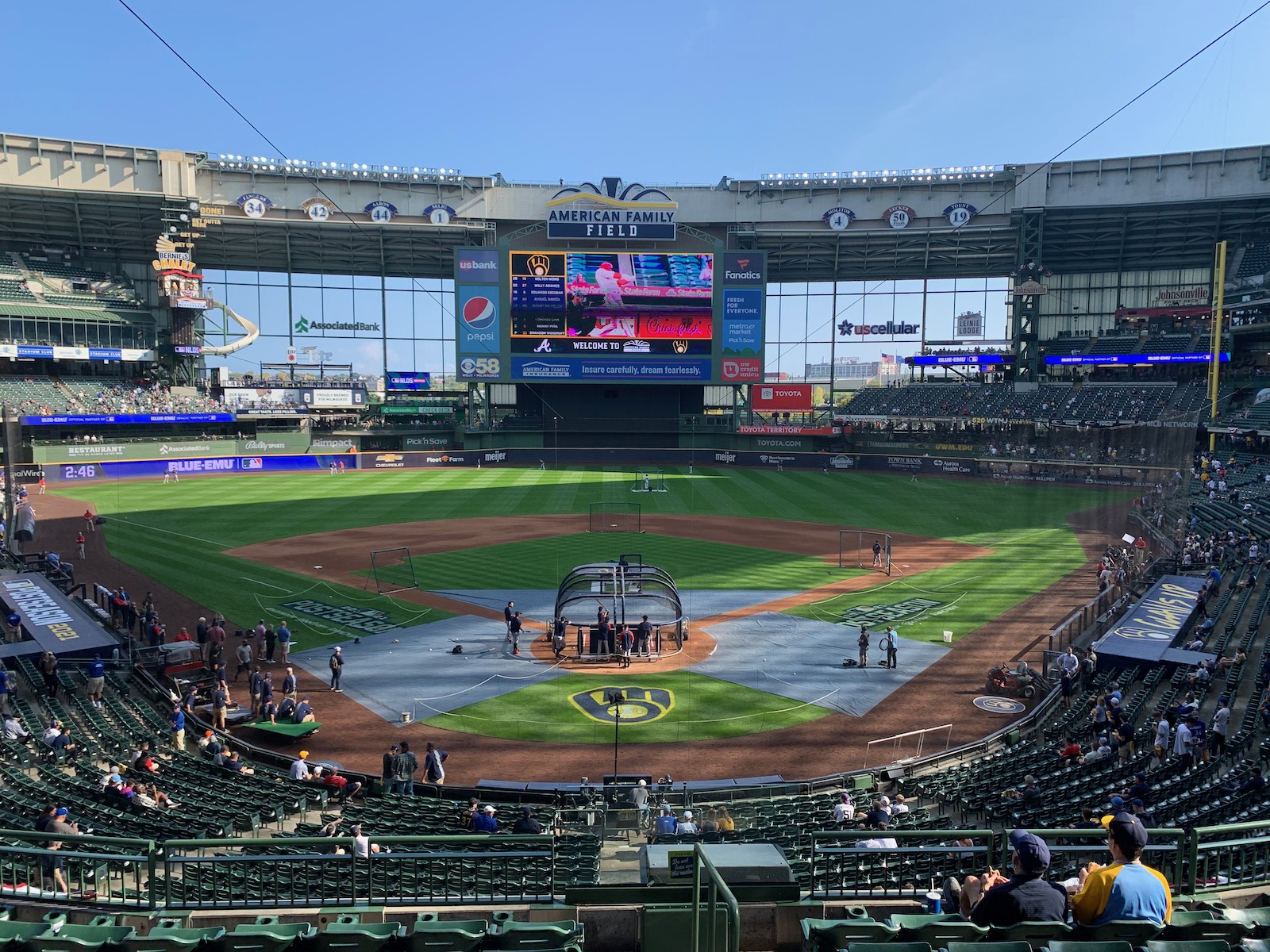
Outfield Panels Aren't Totally Transparent When the Roof is Closed
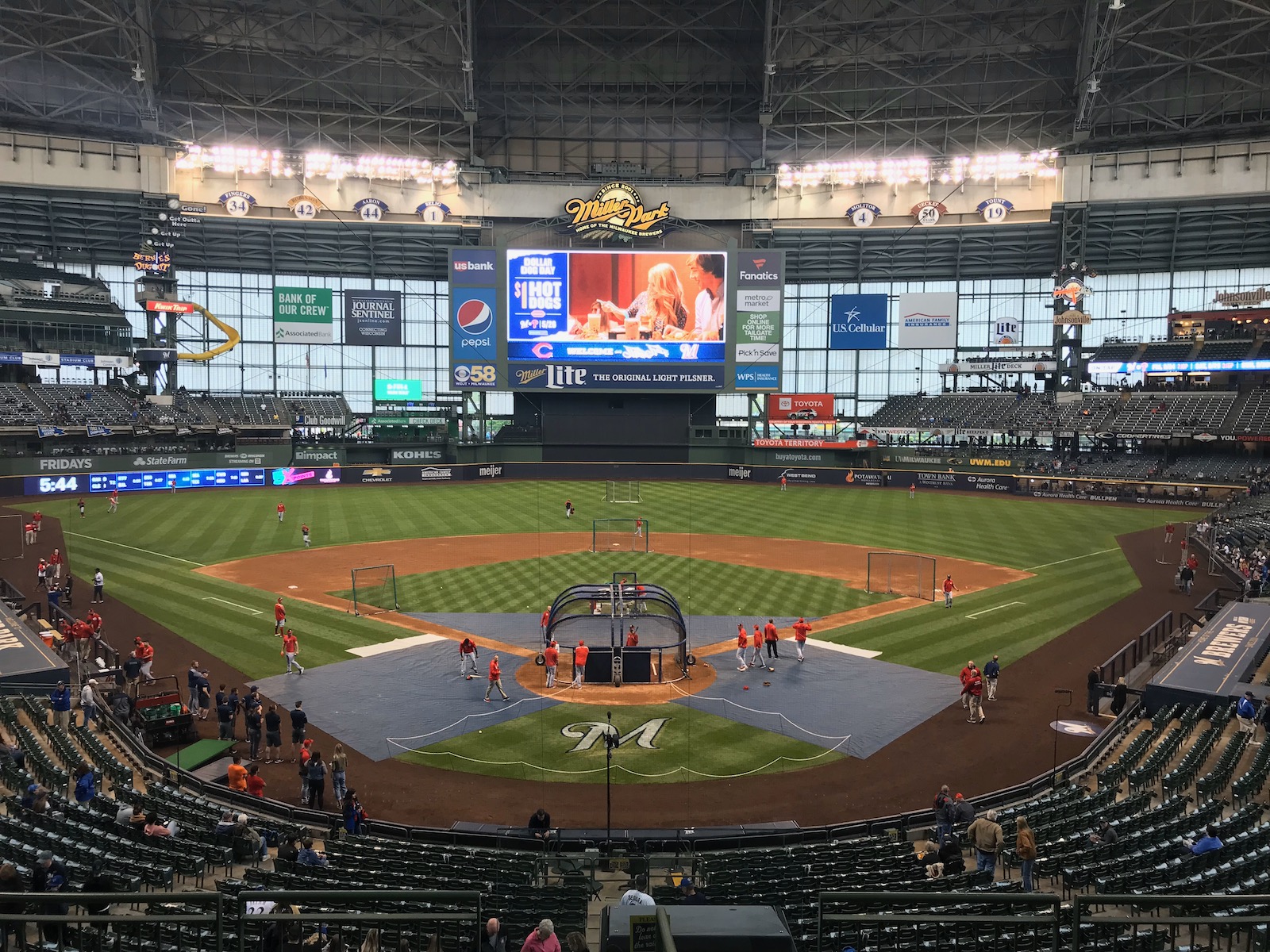
Color Scheme is Still Drab
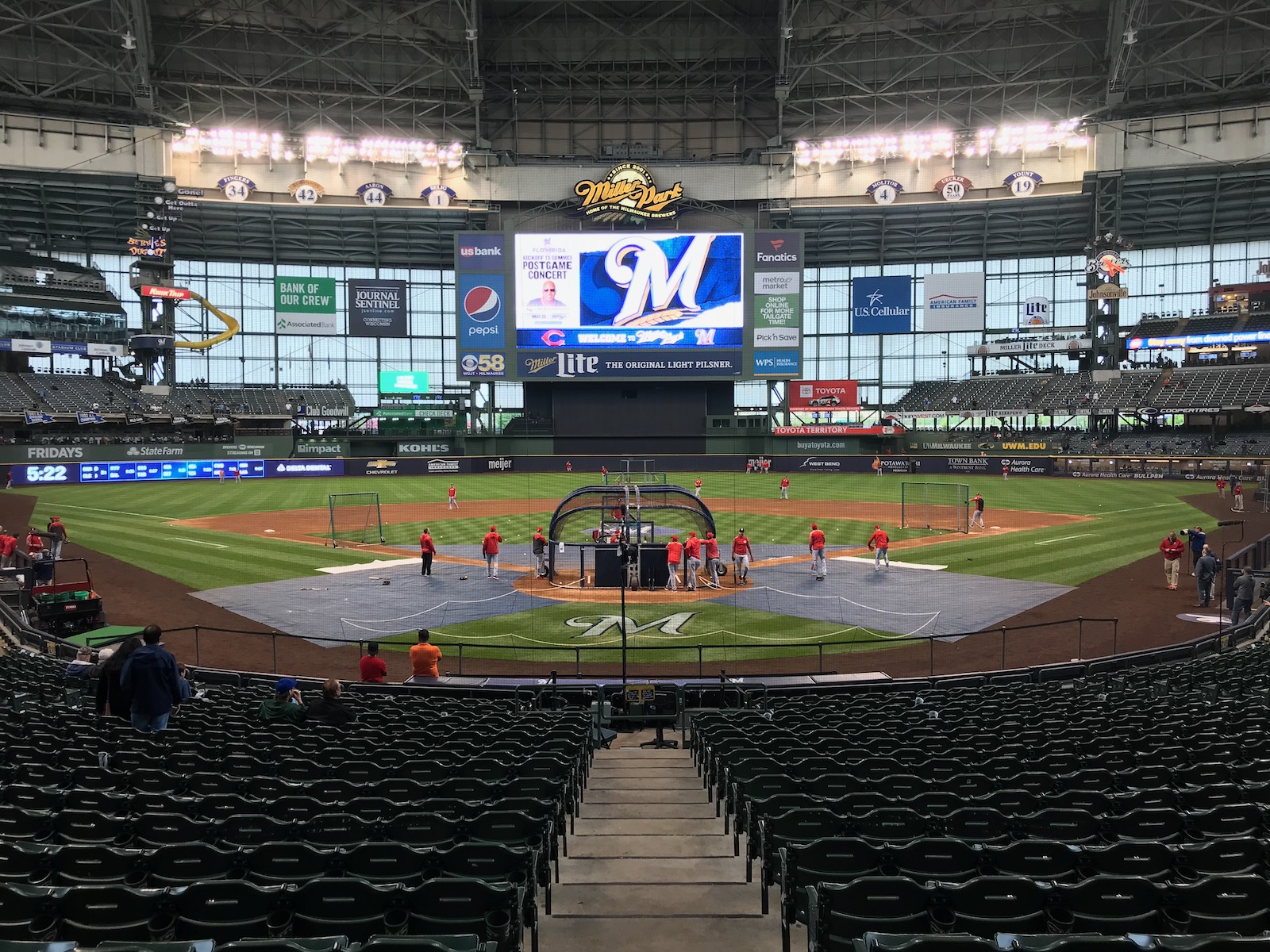
Shadows

Lacks Intimacy
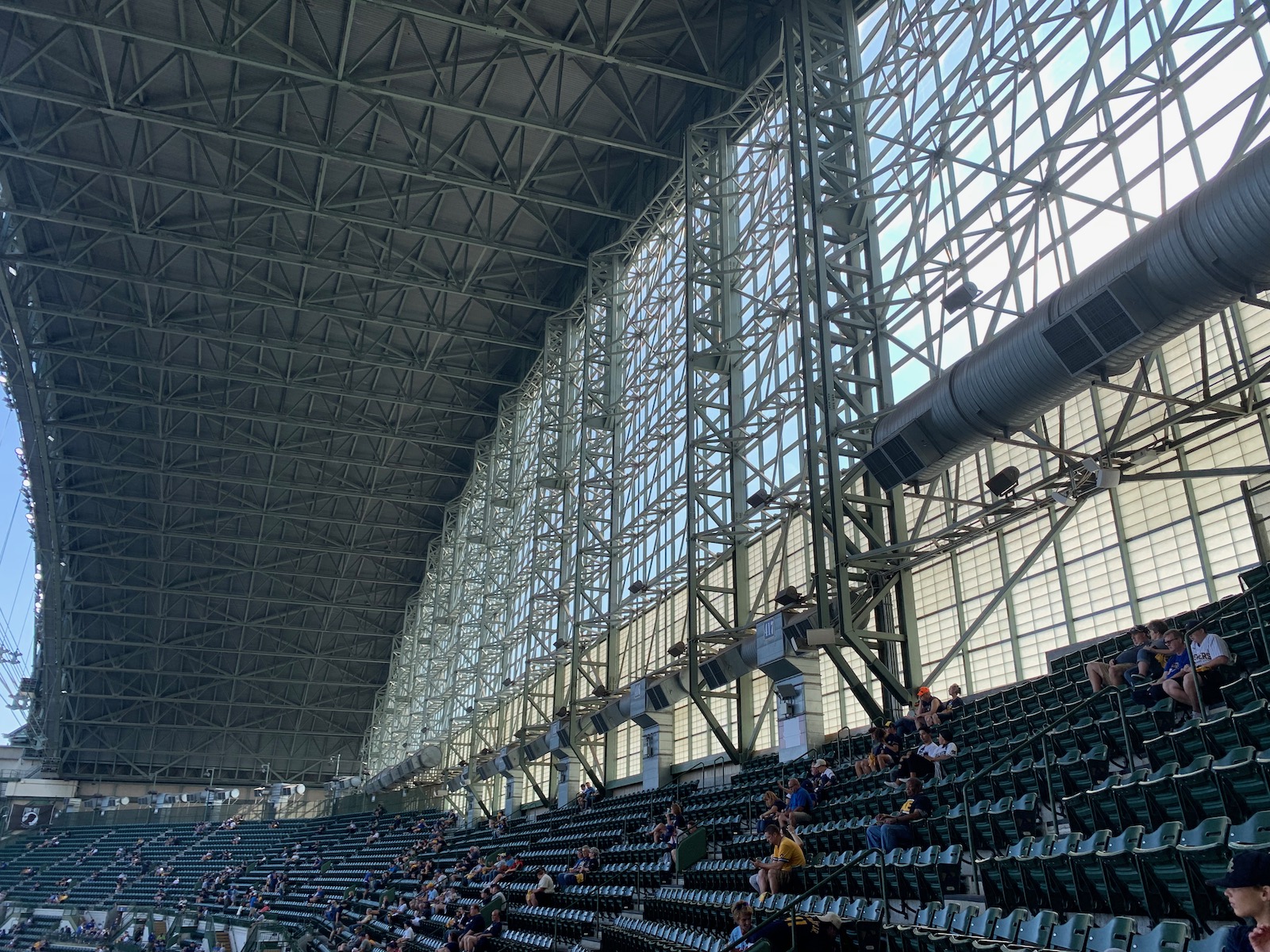
Exterior Architecture
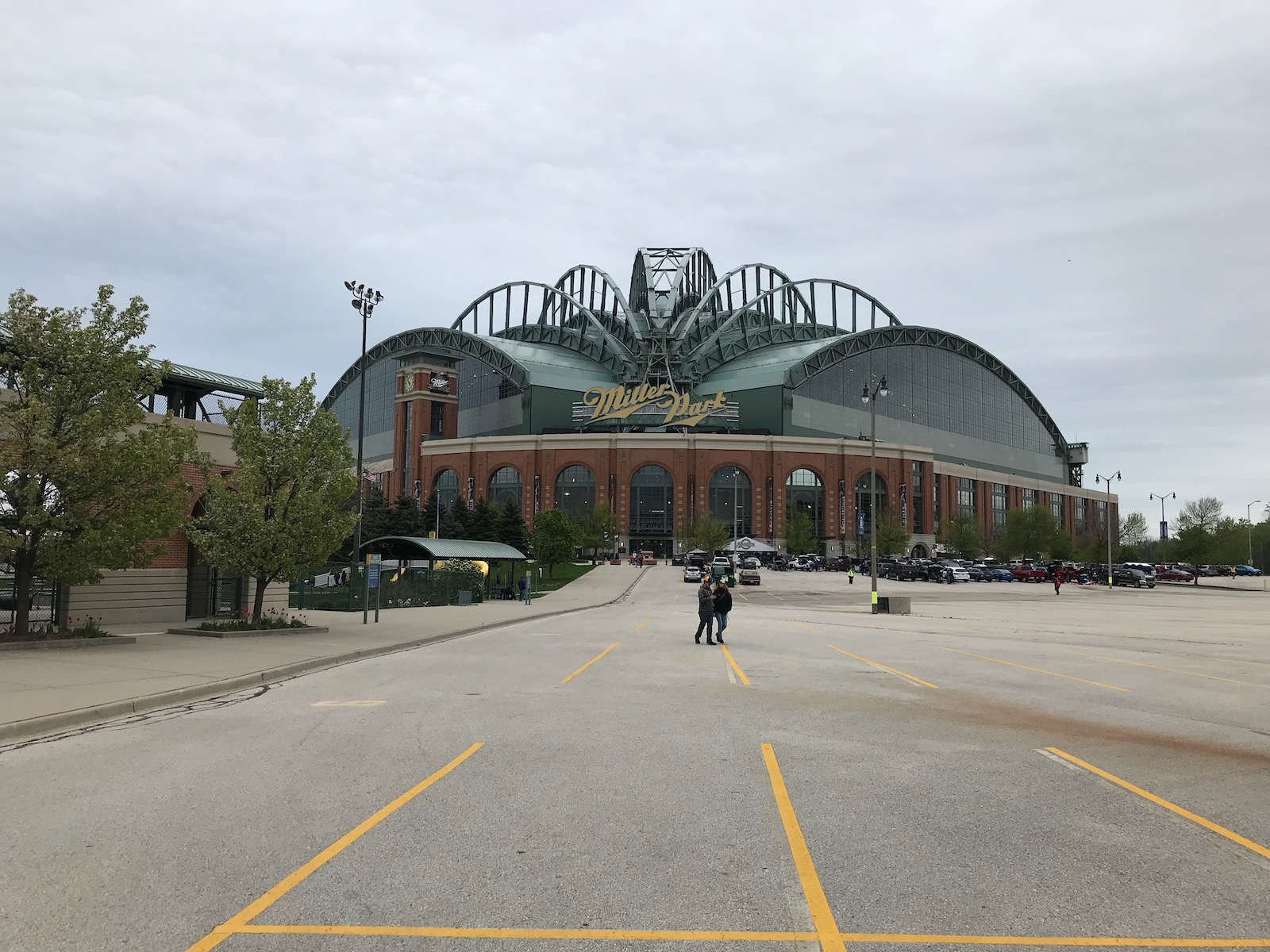
Poorly Designed Main Concourse

Dead, Narrow Space on Center Field Concourse
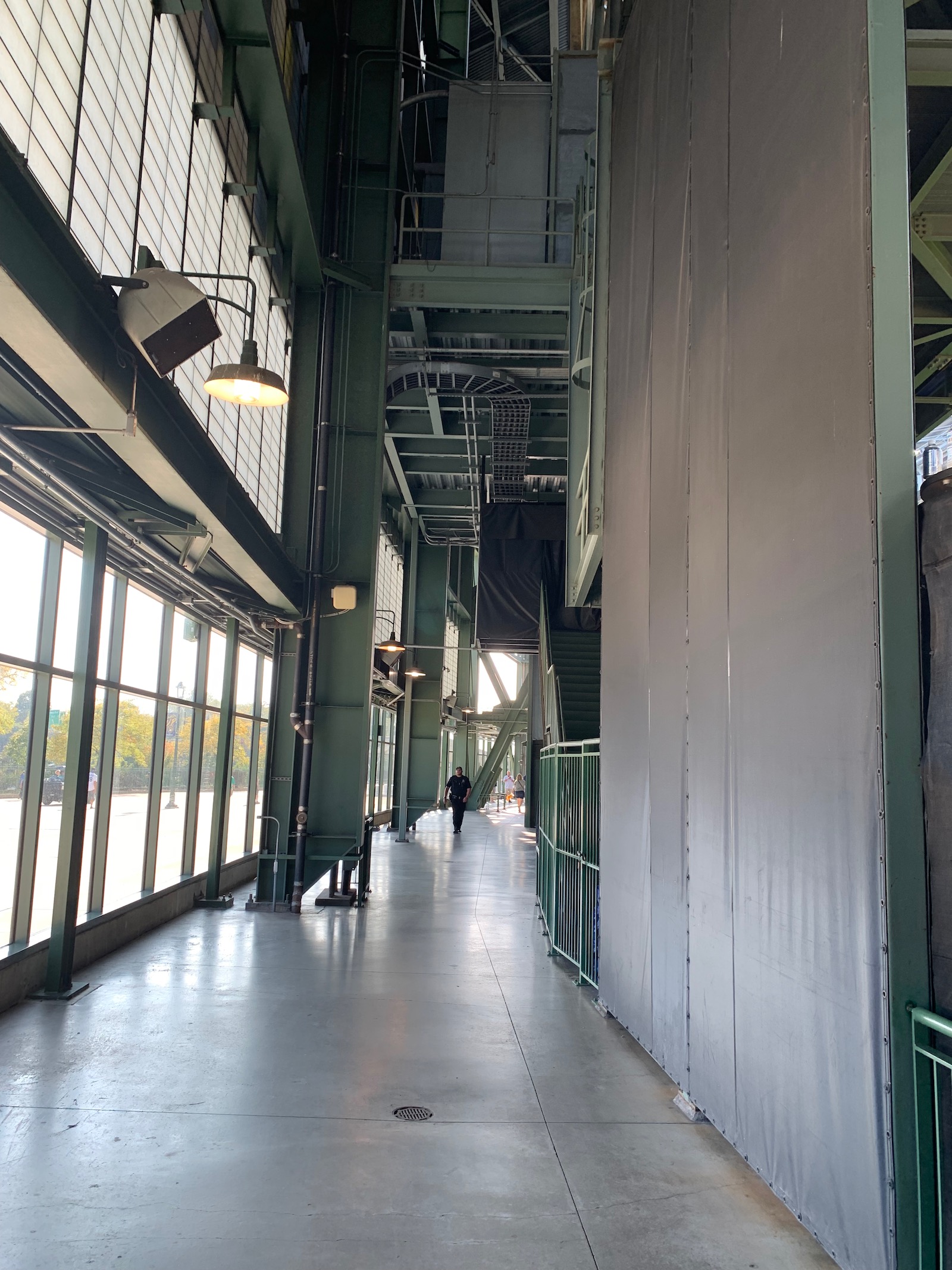
No Cupholders in the Upper Deck
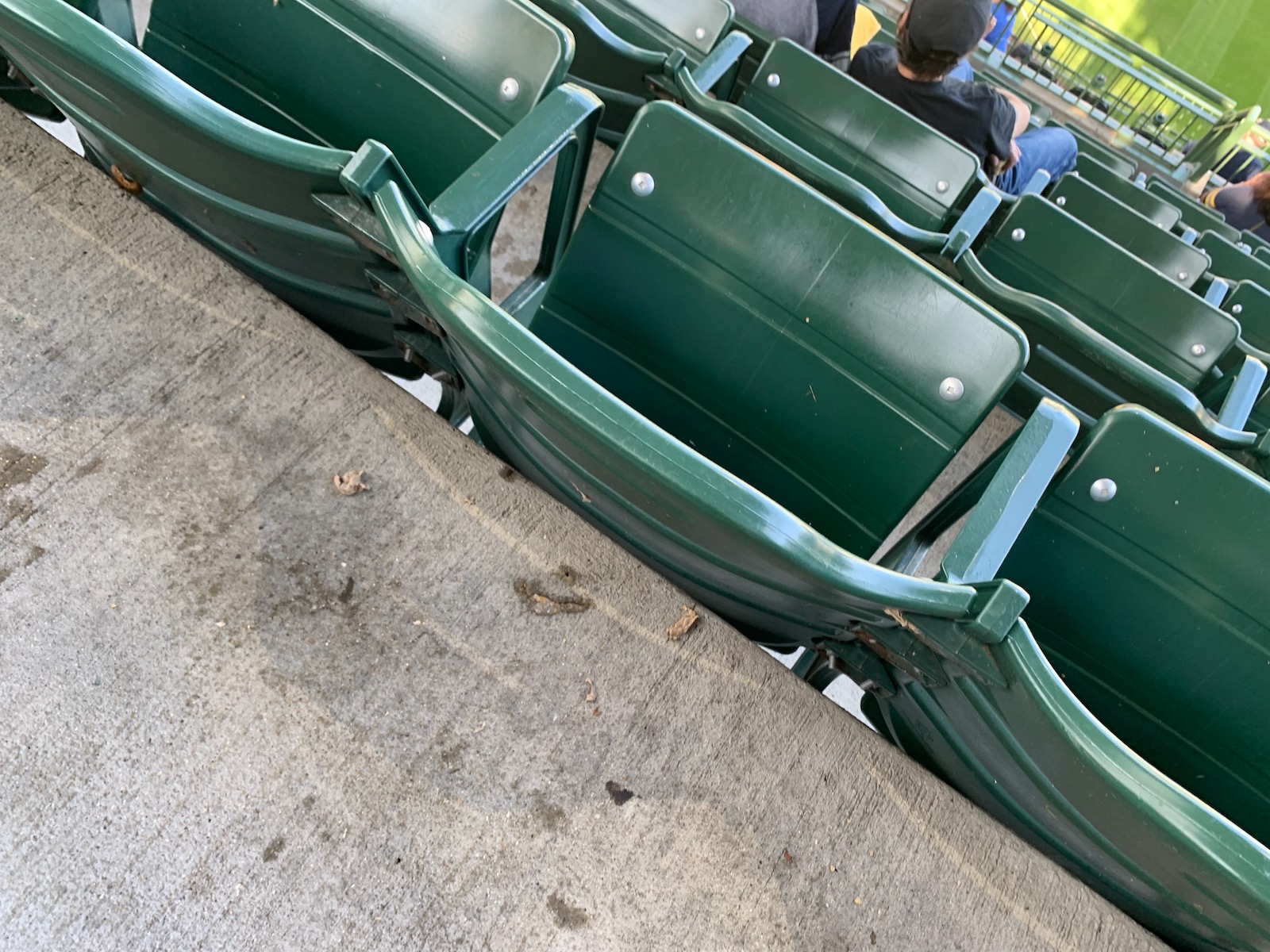
Kid's Playground Too Conspicuous

Historical Exhibits Relegated to Most Obscure Part of the Main Concourse

Lack of Air Conditioning
Best of
Best Neighborhood Restaurant/Bar: None

Best Seats: Field Box, sections 115-120, behind home plate

Favorite Seats: Loge Box, sections 216-221, behind home plate

Signature Food: Brat with Secret Stadium Sauce or Ultimate Wisconsin Cheese Fry

The brat is iconic, but the Ultimate Wisconsin Cheese Fry is a perfect regional food item. French fries topped with fried cheese curds, cheese sauce and bacon. Incidentally, it’s one of the healthier items here. ?
Best In-Park Pregame Spot: Stick with the Tailgating Scene Outside the Park
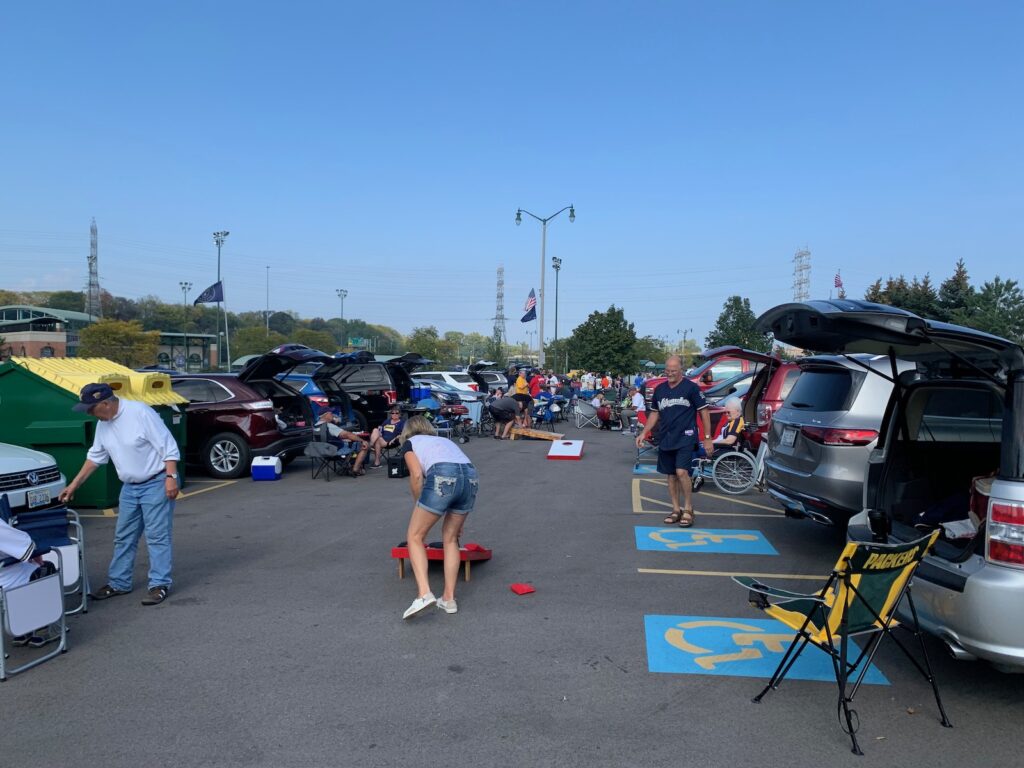
Although, I’m sure the new left field brewery will be fun. Check back after 2023 revisit.